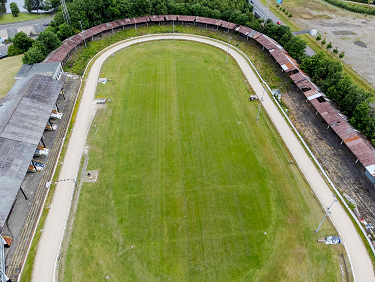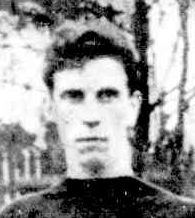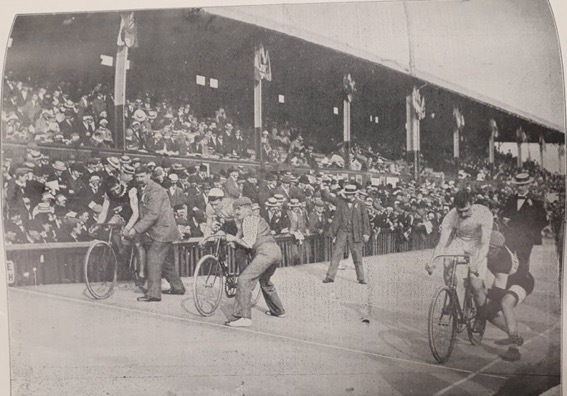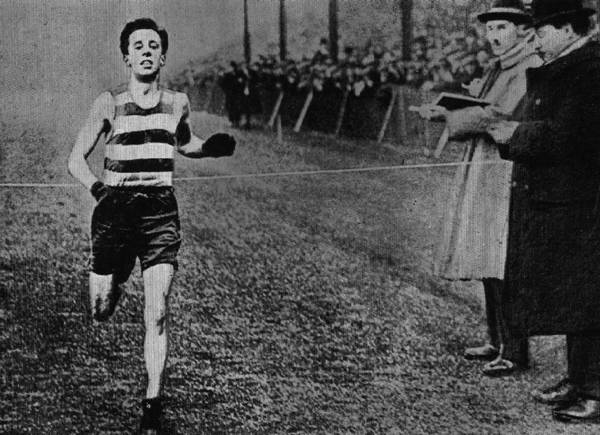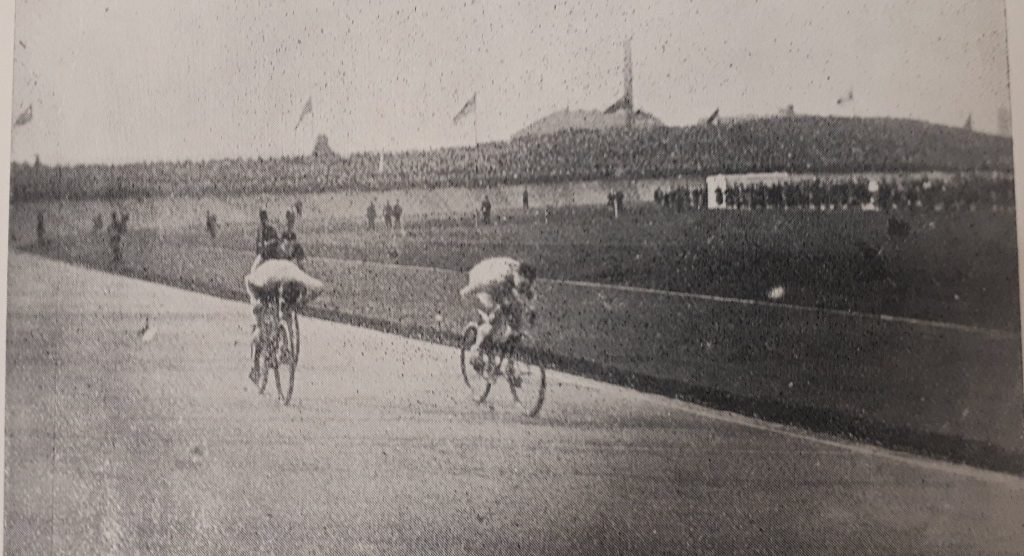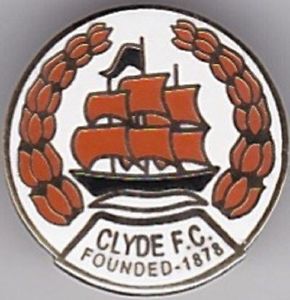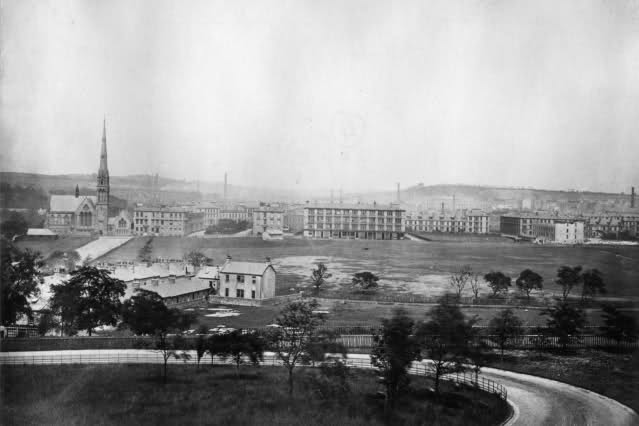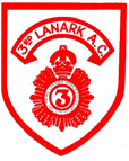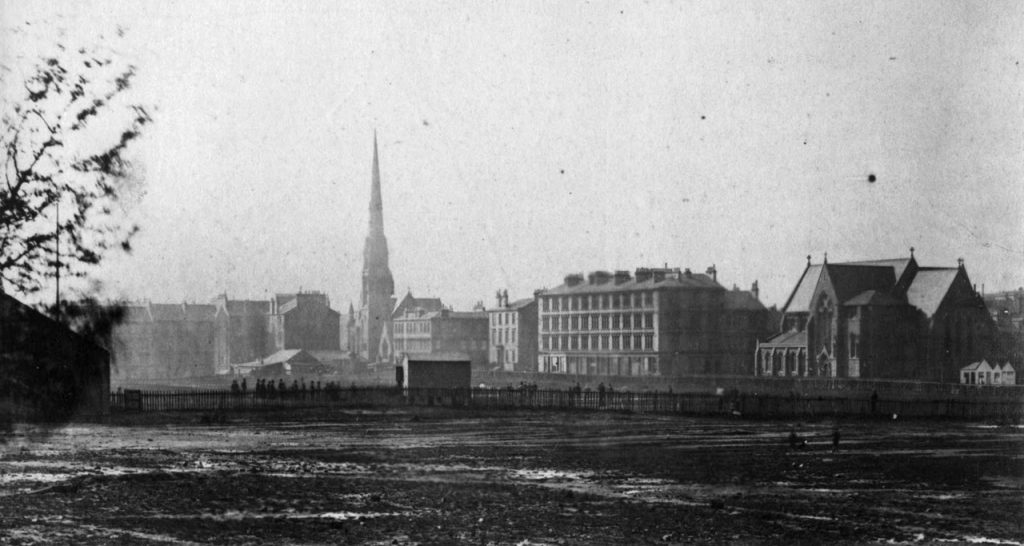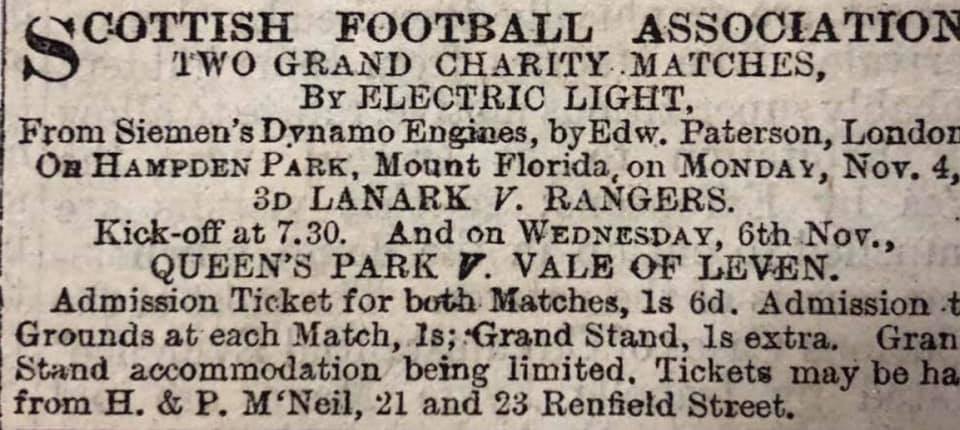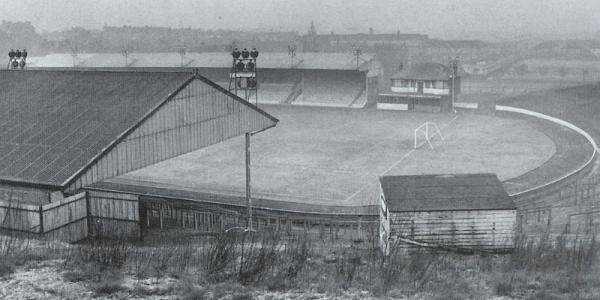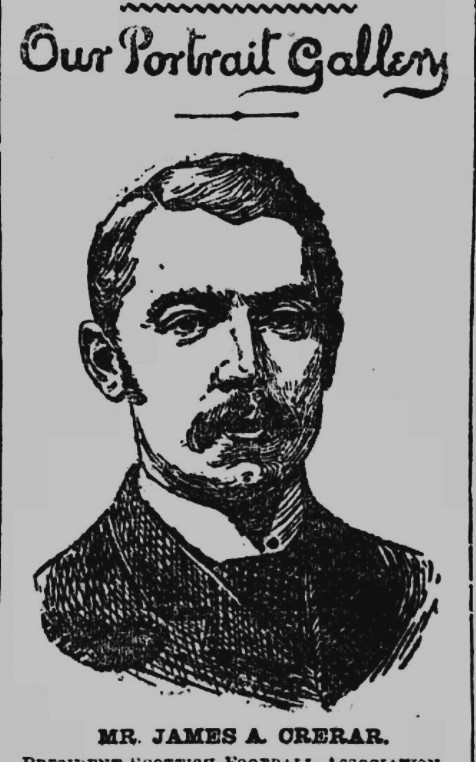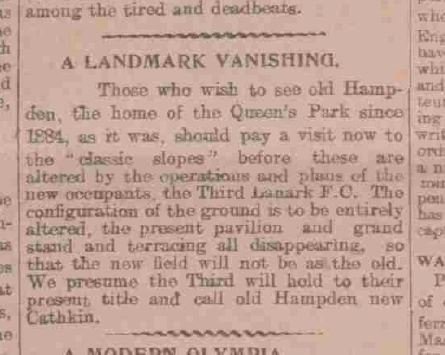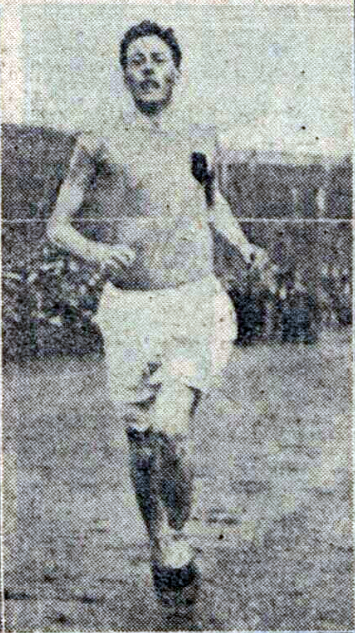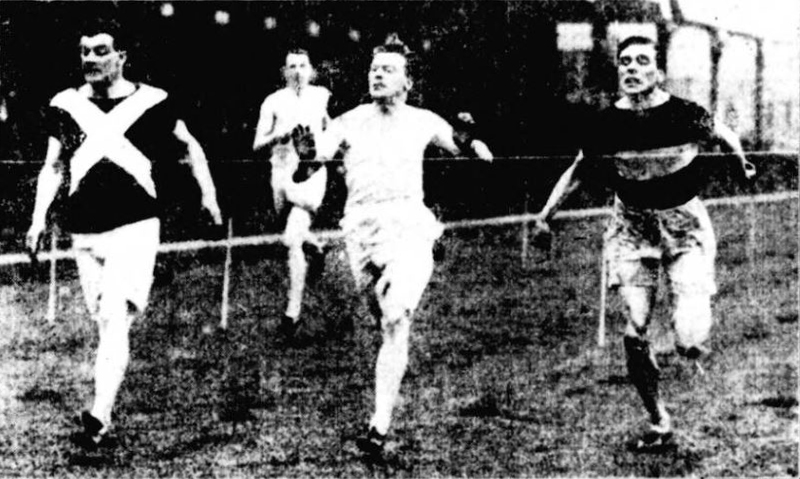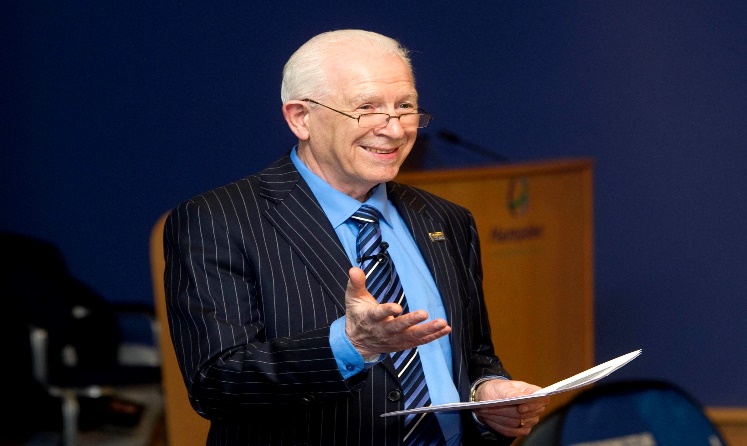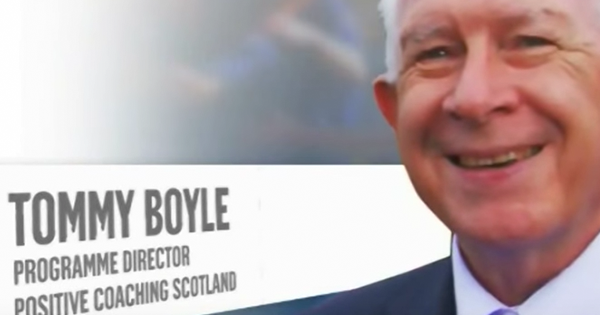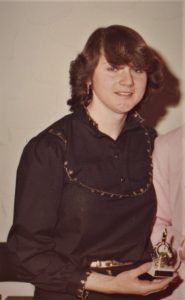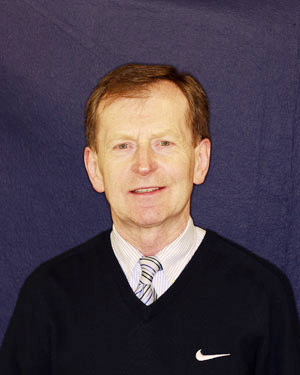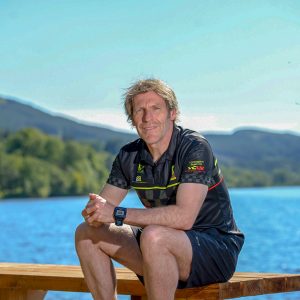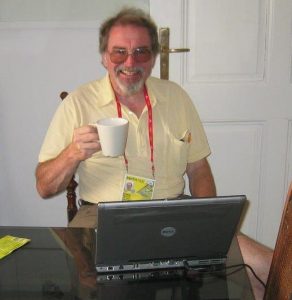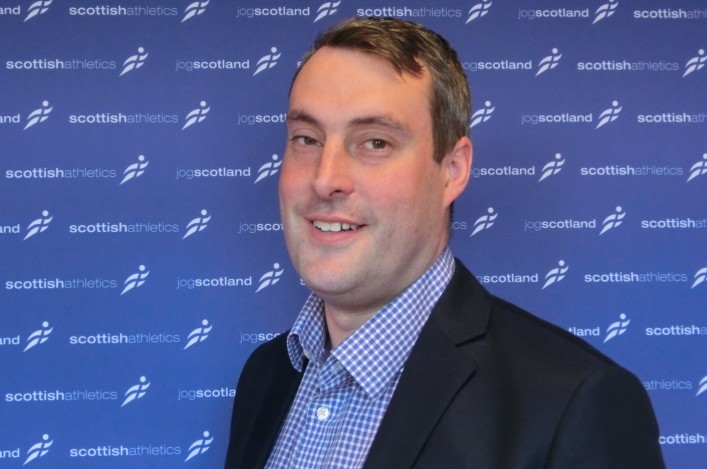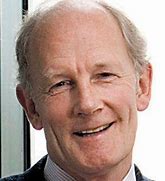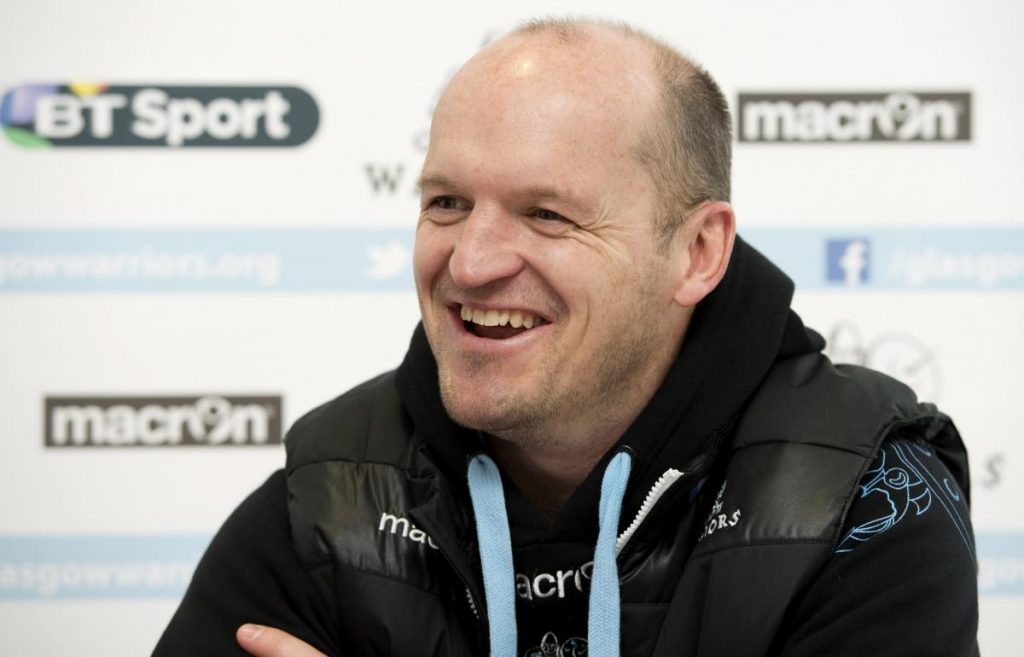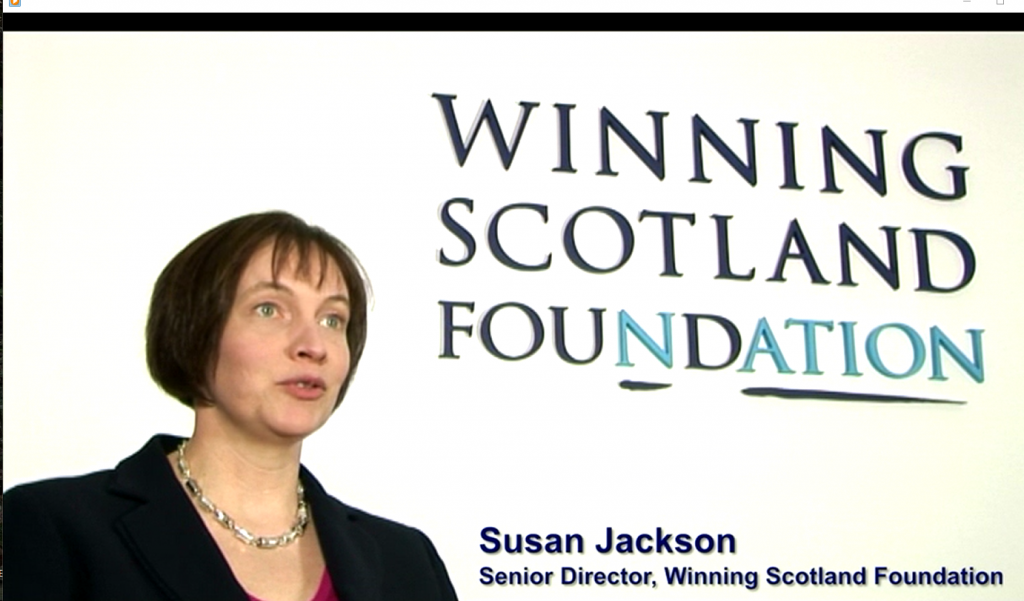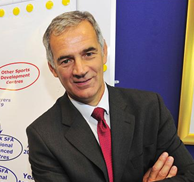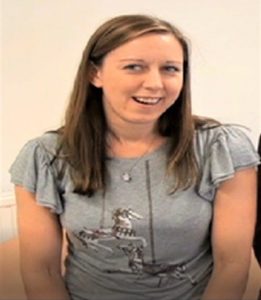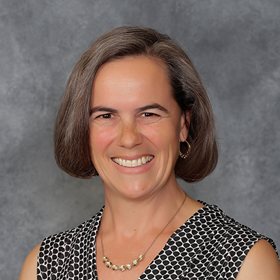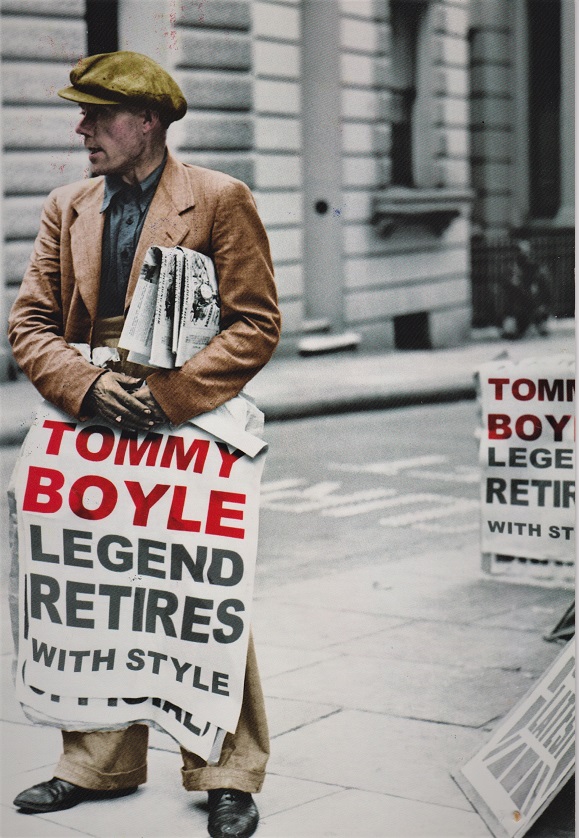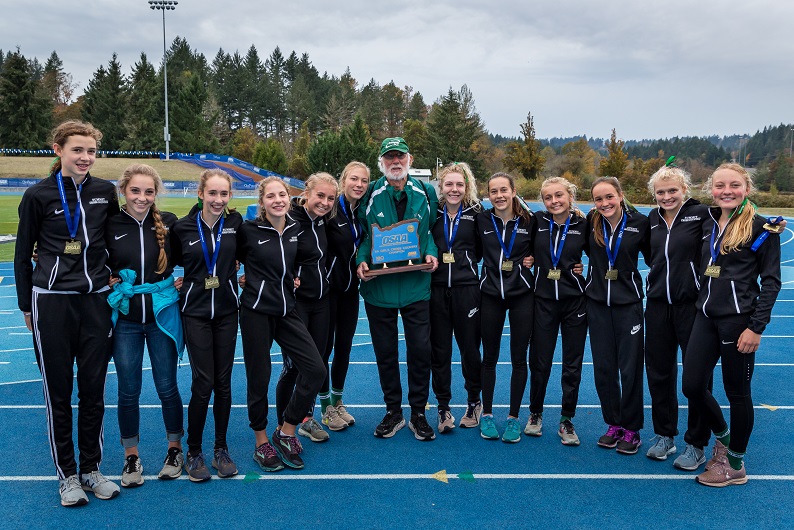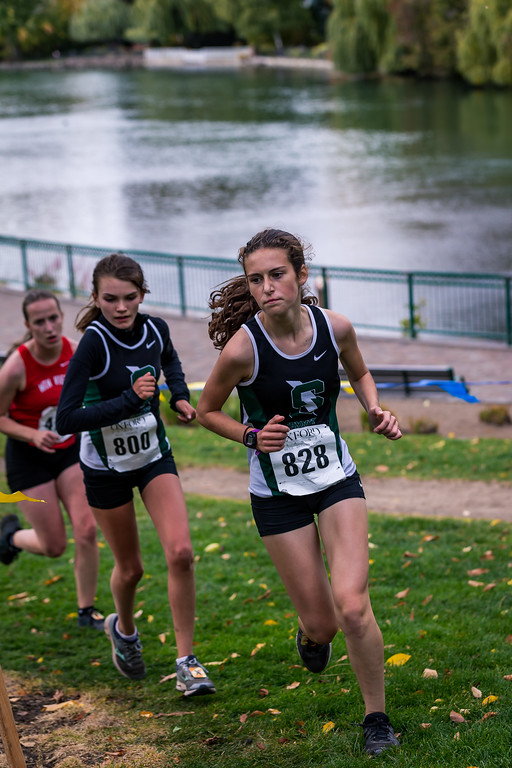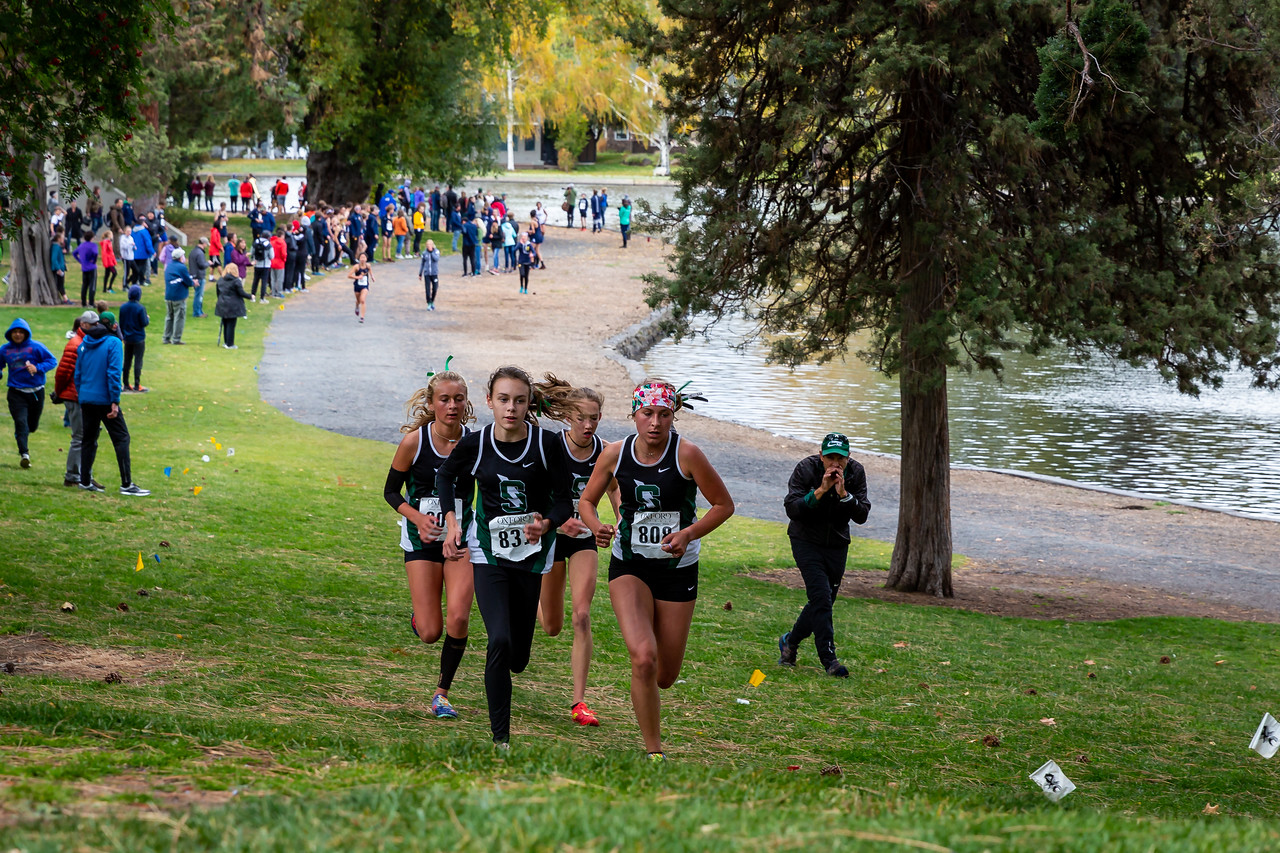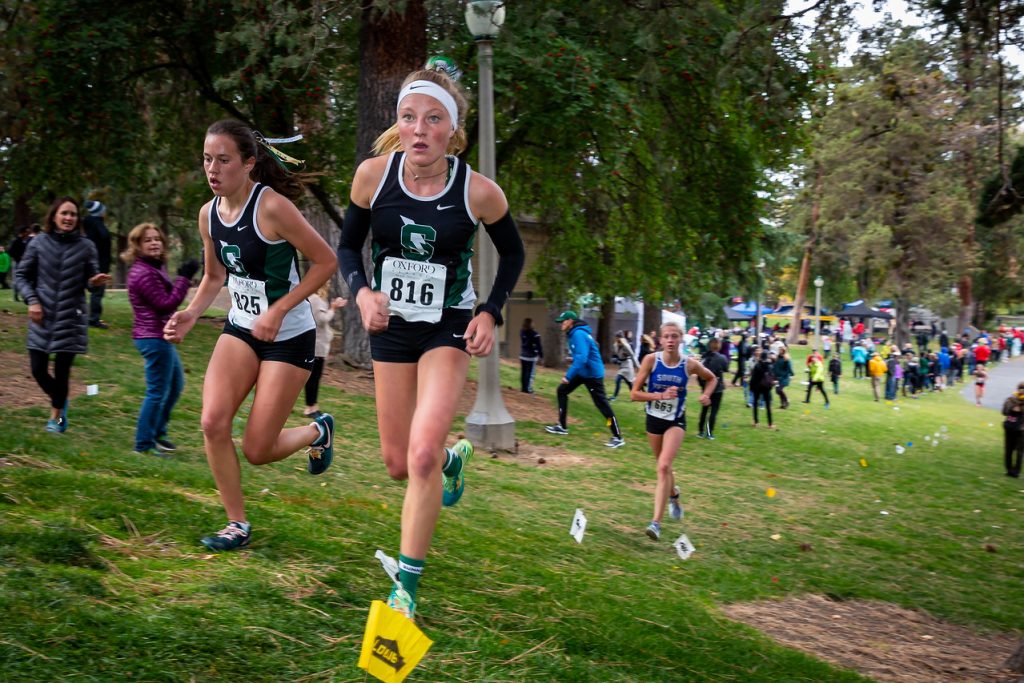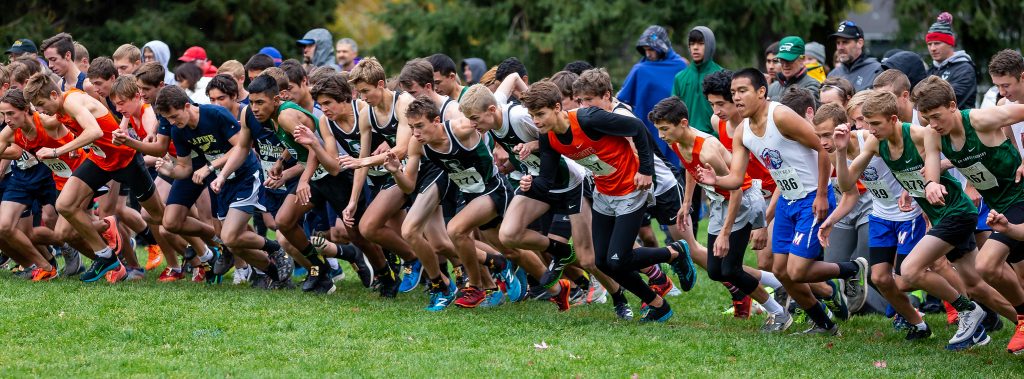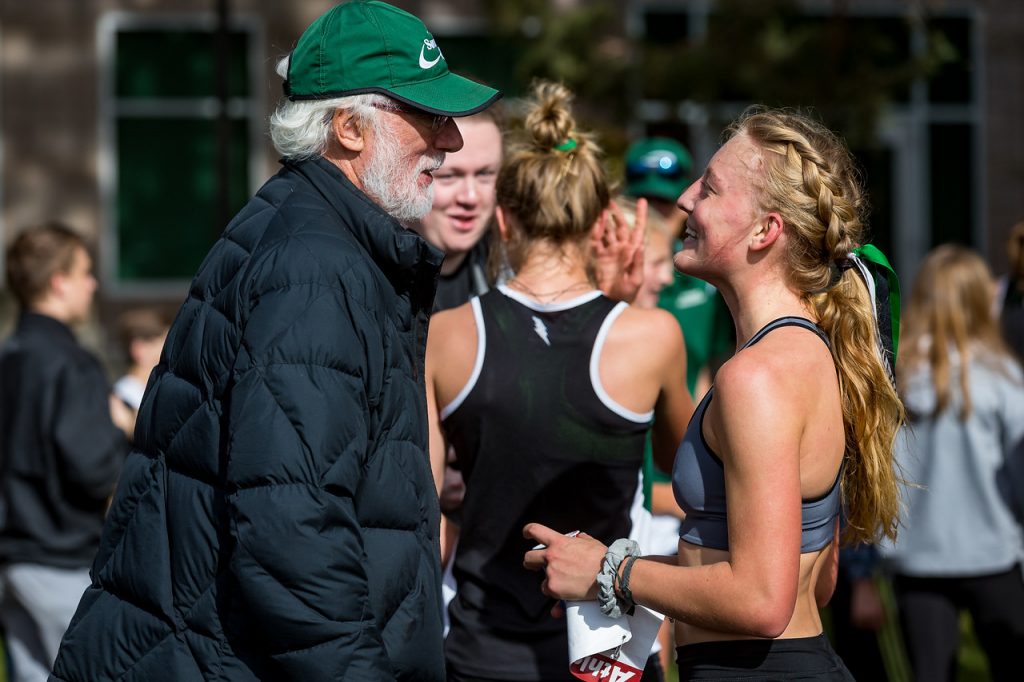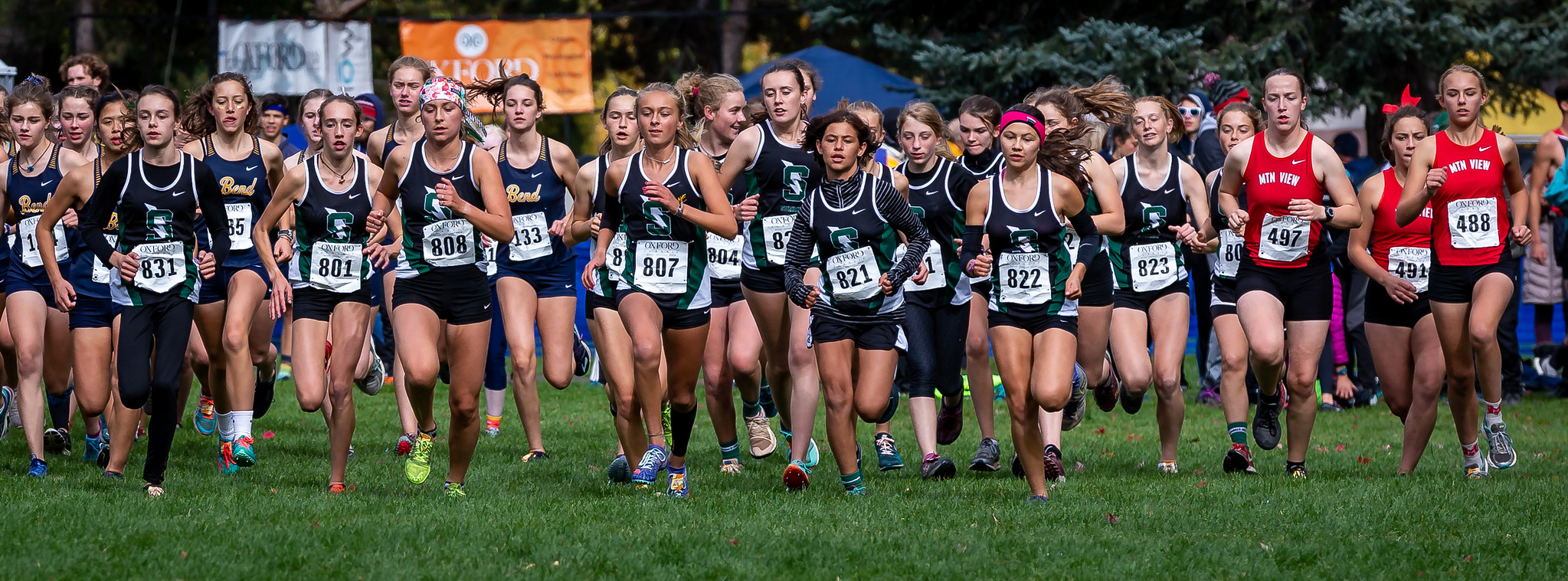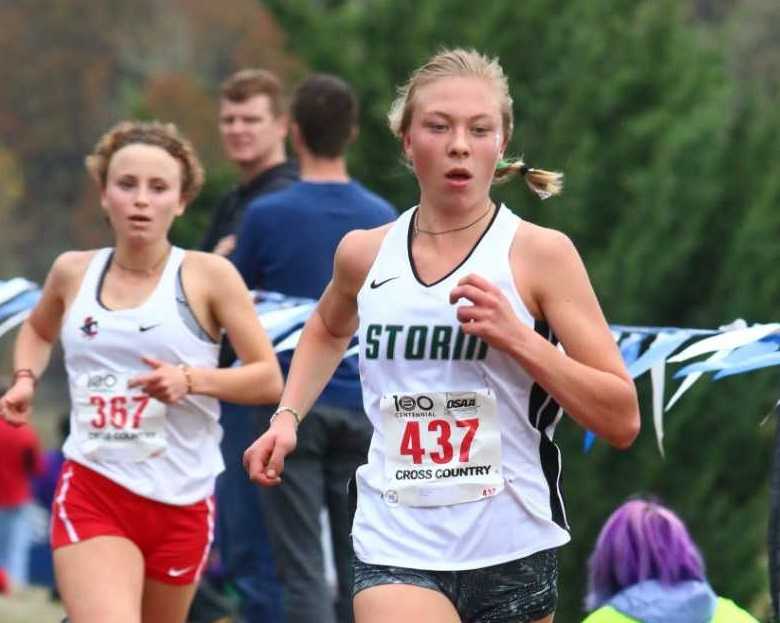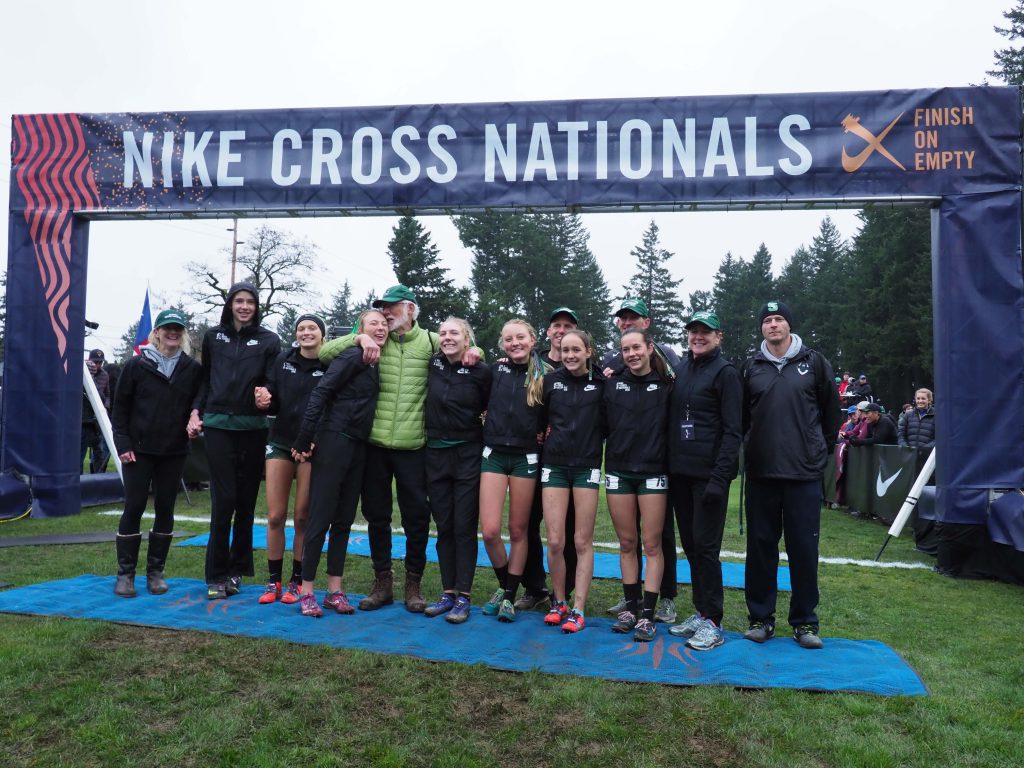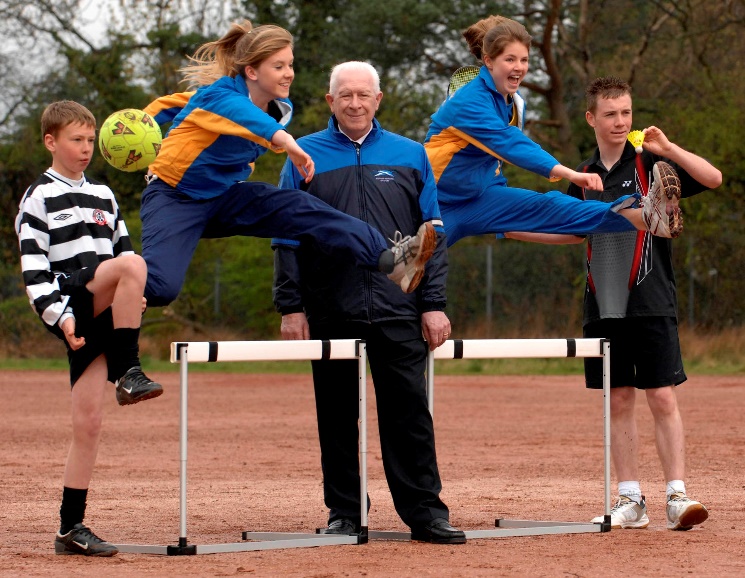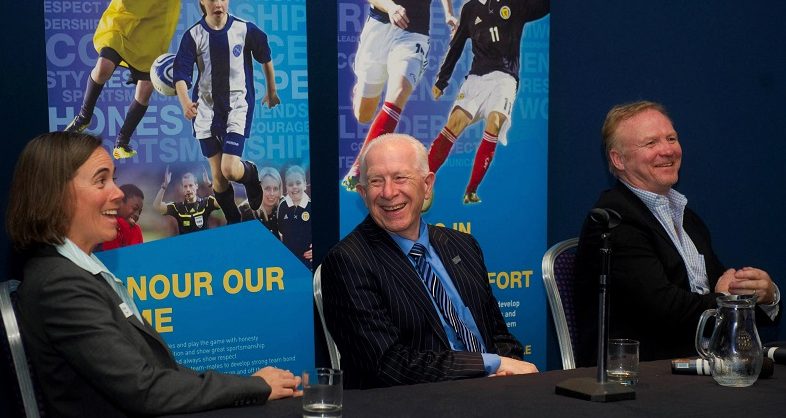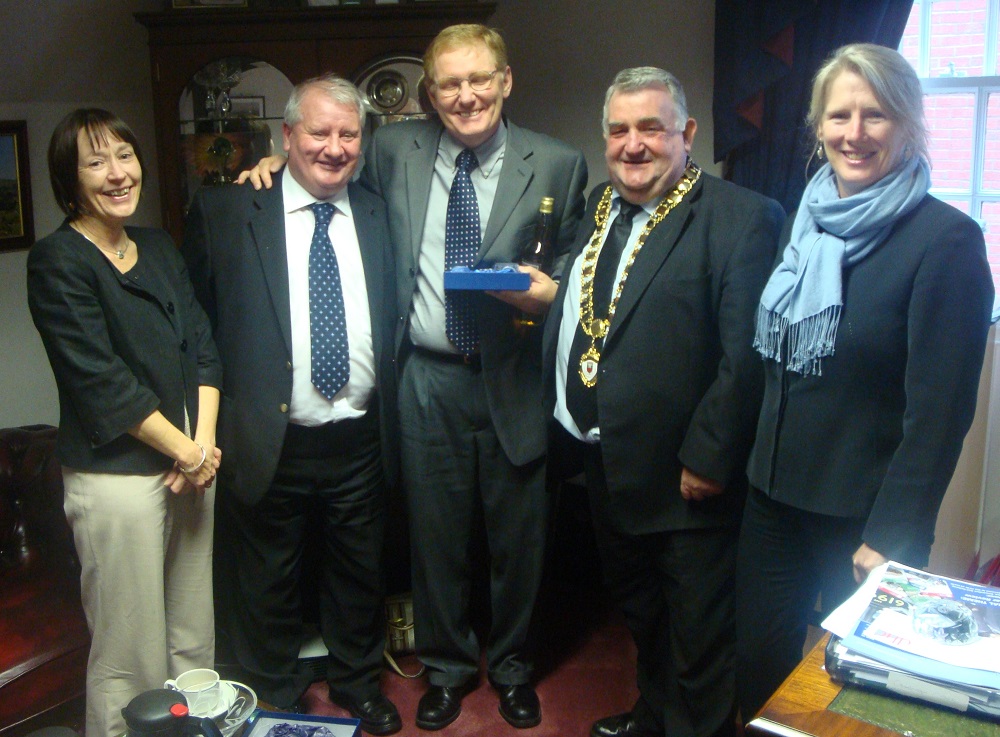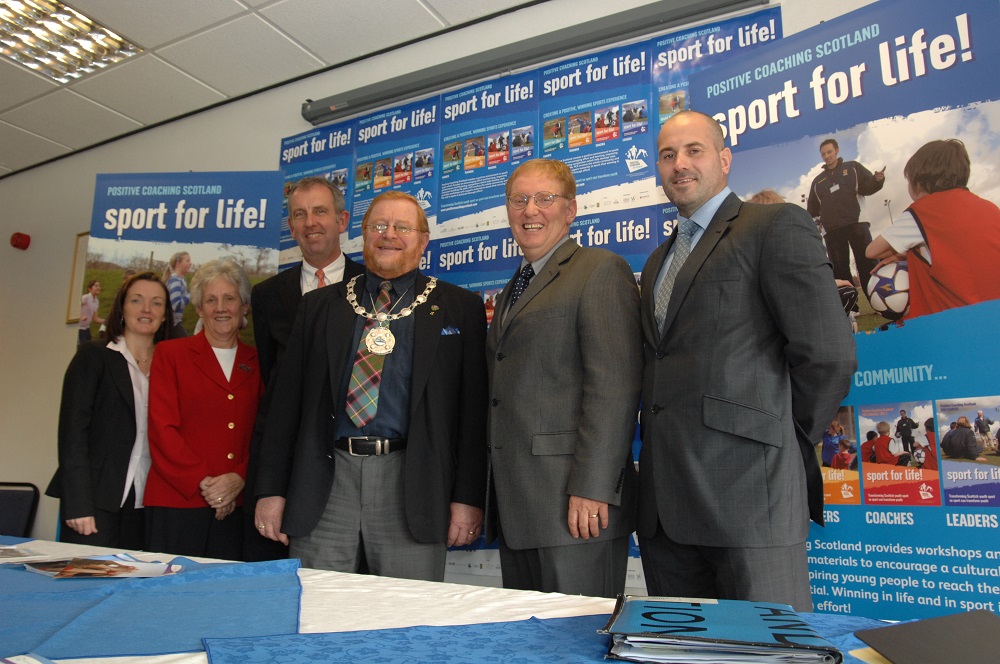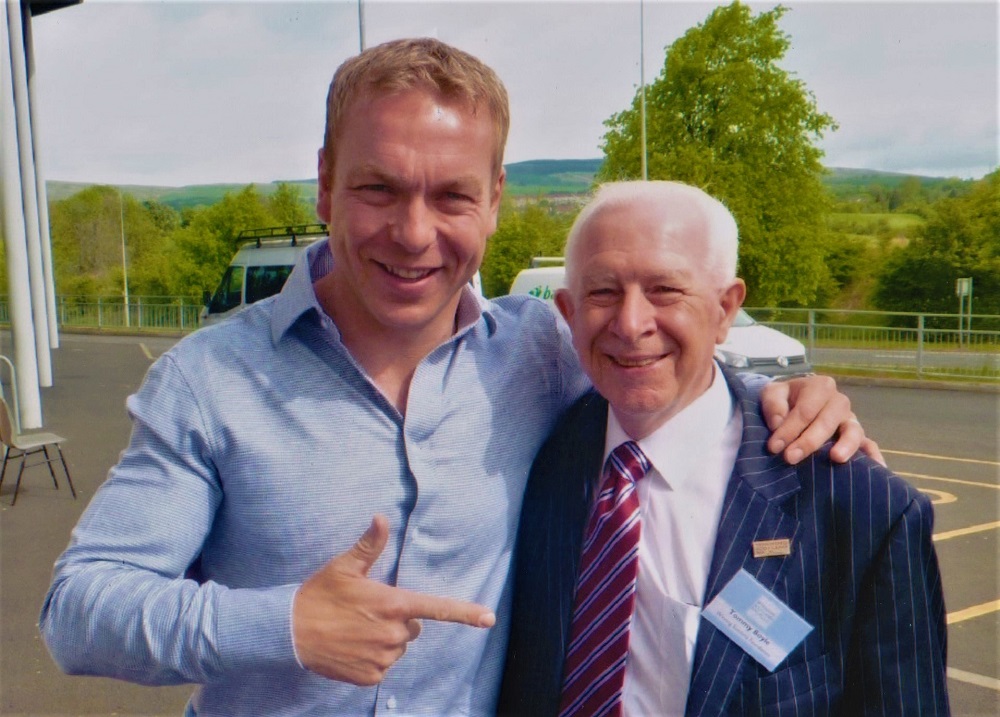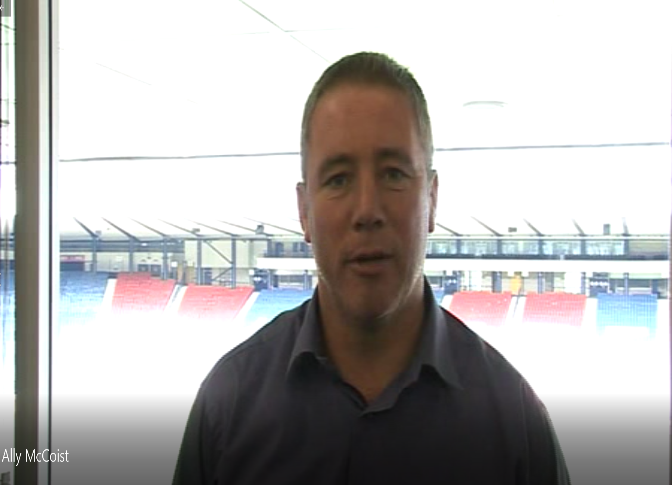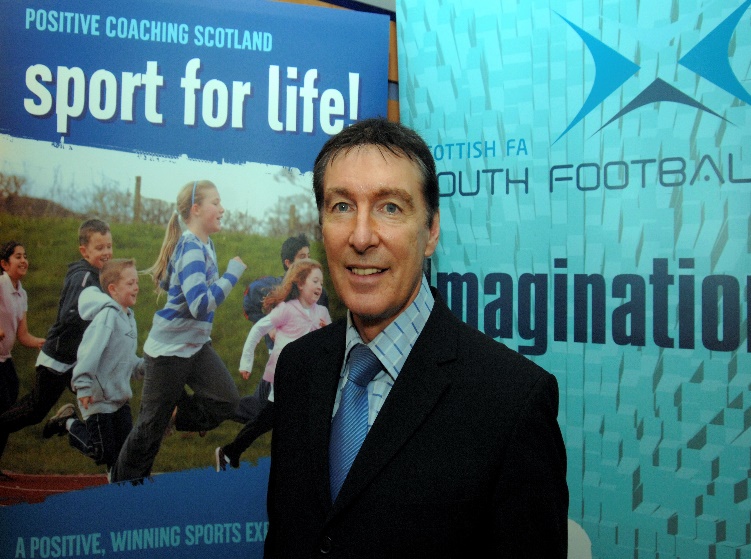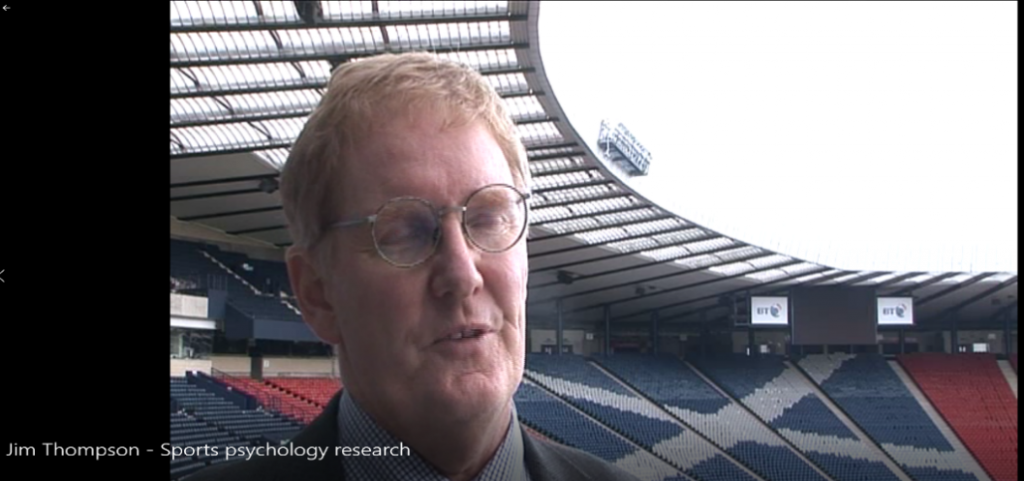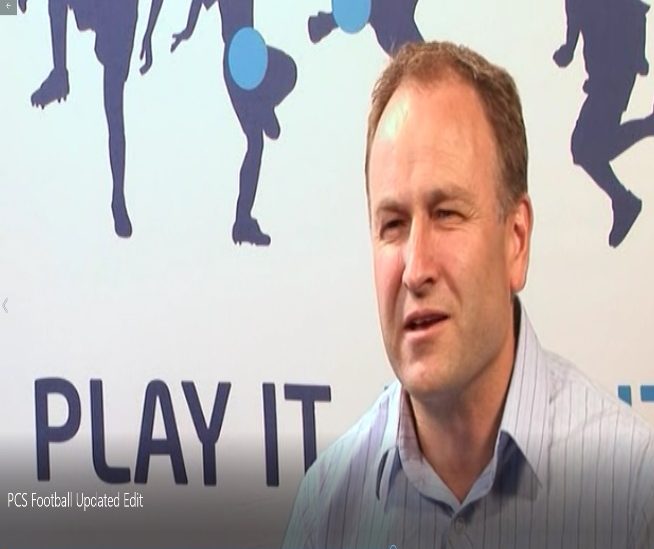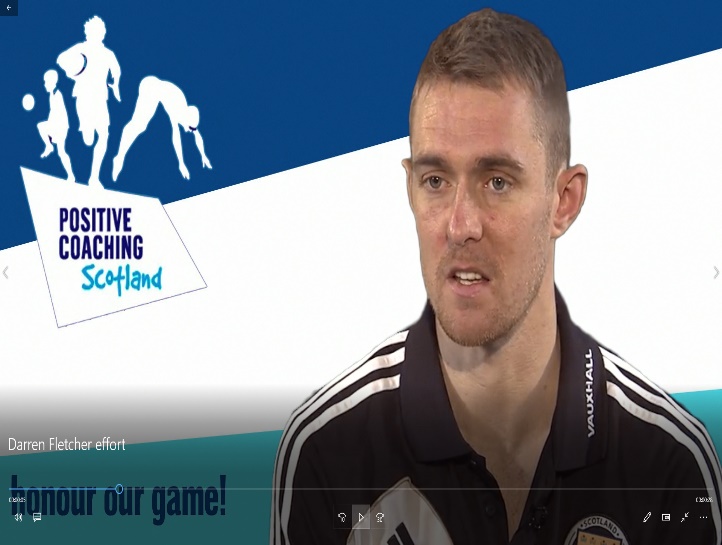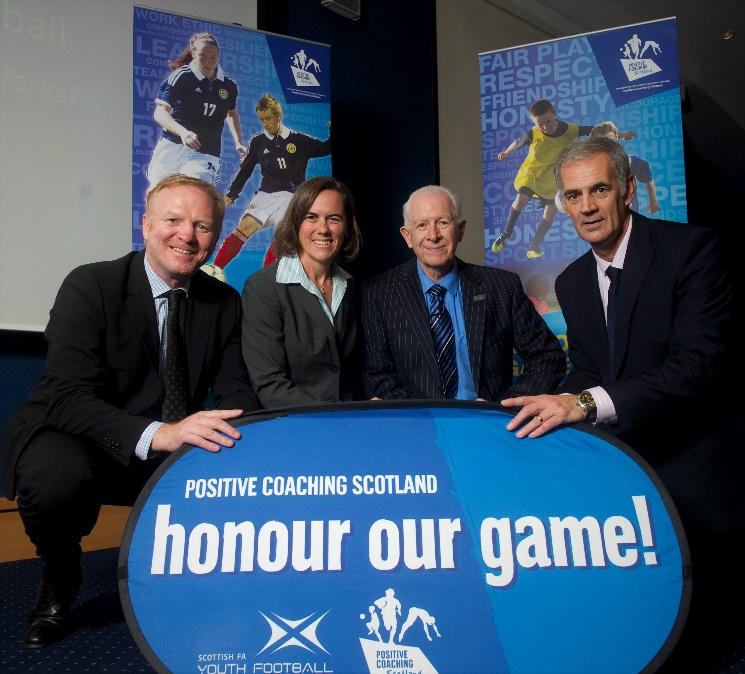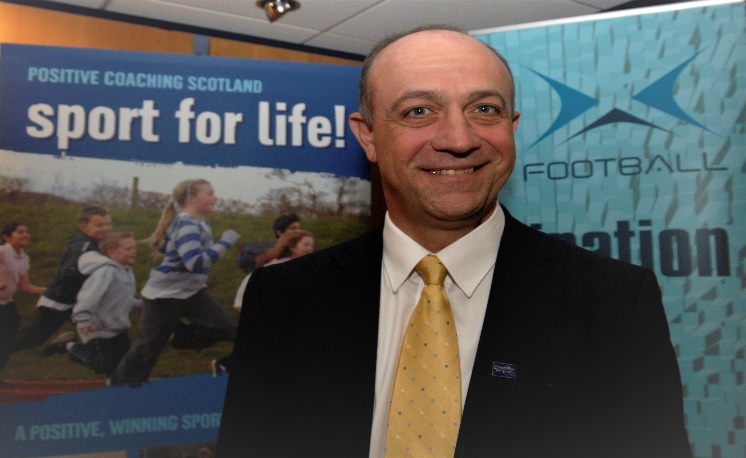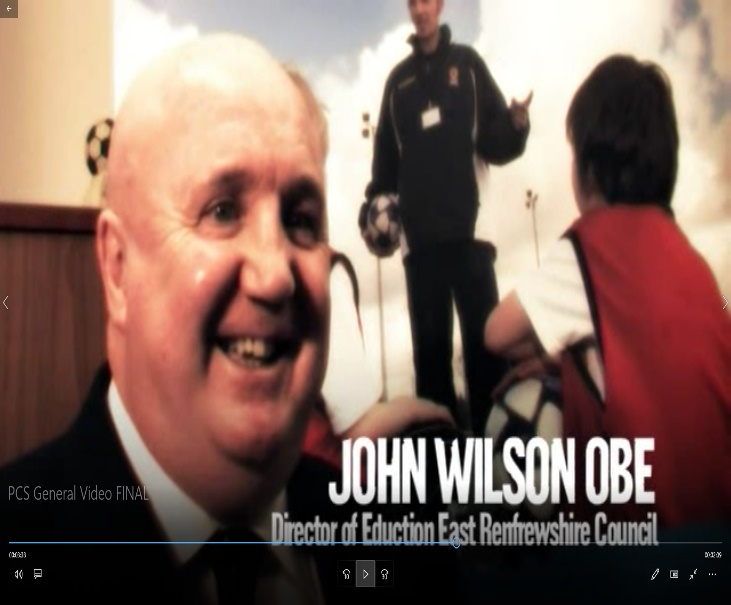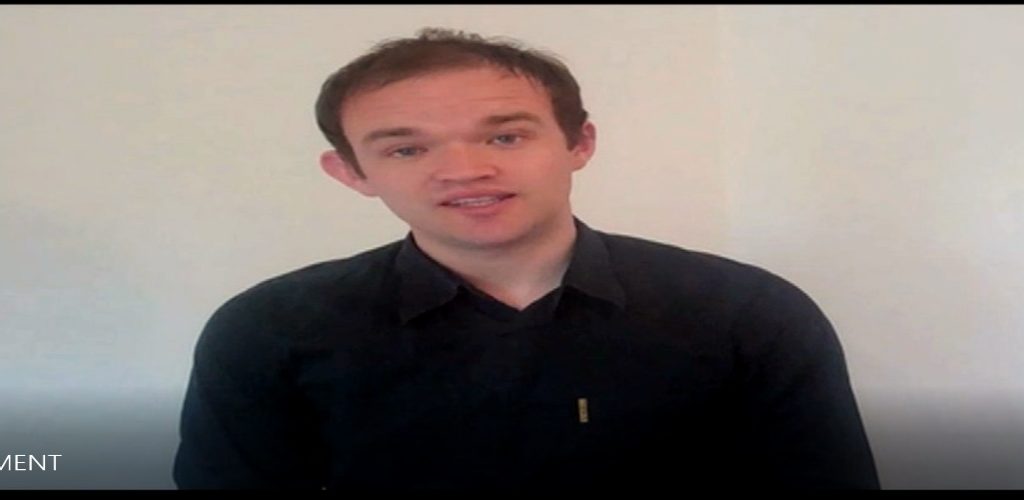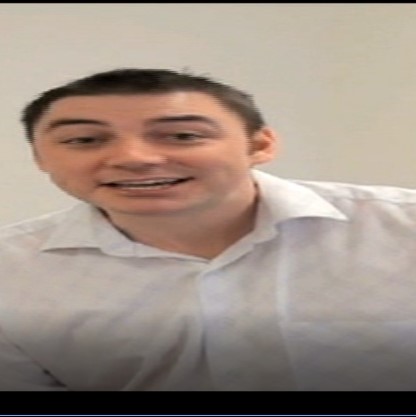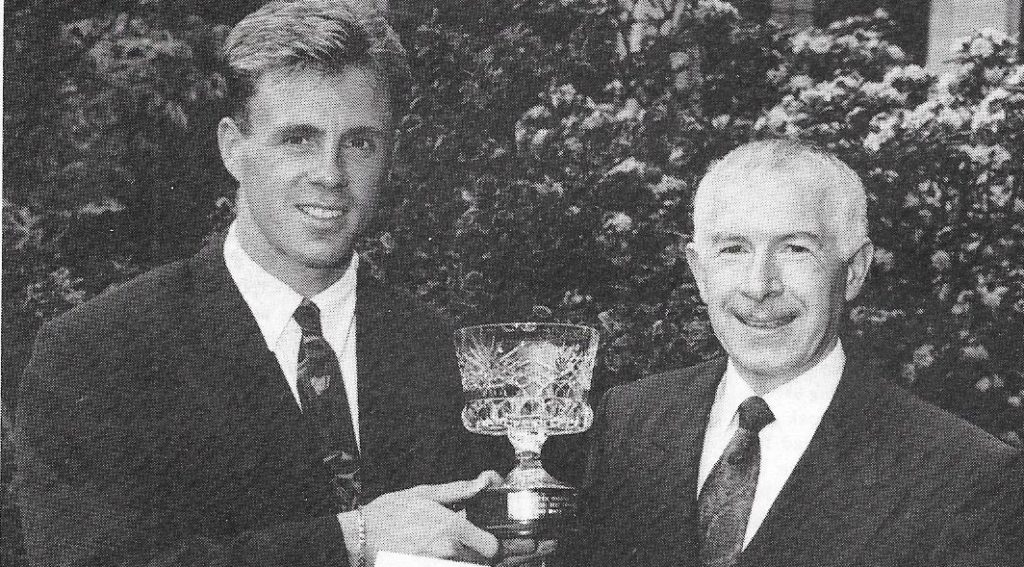
Tommy in 1991 with the Post Office Counters Coach of the Year award : Other contenders that year were Ron Roddan (Linford Christie’s Coach), John Trower (Steve Backley) as well as Mike Whittinghame, Ron Murray (Geoff Parsons), Judy Vernon and John Isaacs (Mike McFarlane)
So far Tommy’s coaching career echoed that of many others in Scotland. He was a young runner who had been encouraged to do some coaching by one of the top men in his club, did the coaching courses, read the books and gone to the conferences. He served his time in a supportive club where he worked on the committee and in all the roles that good club members fill while learning his trade as a coach; he had coached some very good athletes who had won SAAA championships, and he had worked as Group Organiser for the Sprints in Scotland.
Everybody has theories about what a coach is. The international sprinter who said that a great athlete made a coach famous rather than the other way round was maybe half right. It assumes that all the coach of a brilliant athlete has to do is get him fit, point him in the right way and then get out of his road. But how does he get him fit , then how does he decide on the right road and when does he get out of the way? The basic assumption is that coaching an international athlete is straightforward and easy. Then there is the comment made by a Scottish Games athlete that “no matter how often you polish a piece of glass, you’ll never make it a diamond.” The unspoken question is how do you polish a diamond?
Then there is the eternal question about whether coaching is an art or a science with the weasel-words answer usually given that it is ‘a bit of both’. The problem is that the relative percentages are never discussed seriously and most coaches do not have either the time or the inclination to really develop the ‘science’ side of the argument.
Tommy asked himself that question and went further down the science route than almost all of his contemporaries. He then spent much time finding out about the demands of the events he was coaching, the fit between them and the individual athletes in a practical way. Before looking at that, I’ll quote another top class Scottish coach, Ian Robertson, who said that ‘if you are doing it properly, then you can only coach three athletes at a time.’ The clear message being that coaching Olympic athletes is not just a wee hobby. A point emphasised by another high quality coach, Jimmy Campbell, who used to say to would-be coaches, that if they were doing their job as coaches, they’d be heading for “D-I-V-O-R-C-E”
The message seemed to be – almost full-time job. Reevel Alderson in the “Scotland’s Runner” magazine for November 1986, had no doubt where Tommy stood on the science/art divide: “The man who works at the only factory in Scotland to make mainframe computers takes a scientific approach to coaching. And at the European Coaching Convention this month he’ll unveil the results of that work. Graphs will be produced detailing minutely the development of his protege Tom McKean from competent club runner to the man who, if meticulous planning goes well, will take the World Championship 800 metres title. It’s the sort of scientific and professional approach to athletics which is needed in Tommy’s view if Scotland’s athletes are to reach their full potential. In fact, professionalism is, in his eyes, the only way forward from the disappointment of the Commonwealth Games.”
As for Tommy, if we look four years down the line (1991) at part of an article in ‘Scotland’s Runner’ number 60, we see what kind of detail Tommy went into. The complete article can be found at this link where the amount of detail that went into his work with Tom can be seen.
Tommy is seen here to have analysed the demands of the event and measured his runner against these. We all do that but the extent of his analysis and measuring went beyond the usual for Scottish coaches. He was using terms that not many were even familiar with, never mind using at the time, such as OBLA runs, mmols of lactic acid. video feedback, etc. The question was whether these were these empty measurements which led nowhere or were they meaningful measurements which were of practical use? To find out we should start at the beginning. The information quoted below comes from a paper that Tommy delivered in 1986 on Tom’s early development between 1976 and 1980.
Tom McKean (Date of Birth 27th October, 1963) had joined the club as an 11 year old in 1974. and by 1980 it was clear to Tommy that he had a big talent on his hands.
“The knowledge gained during that period (as a club coach up to 1980) has proved to be a valuable asset which could not have been obtained in any other way. However, the tremendous enjoyment derived, and enthusiasm generated were gradually being eroded by my over—involvement in administration and dealing with increasing numbers of very well-intentioned but totally blinkered individuals. Fortunately, I was forced in 1980 to take a very serious l00k at my commitment to athletics as we were expecting a family. I asked myself a question which we repeatedly ask our athletes — “What do you want from athletics” — answer — “To coach athletes”: solution — simple — remove everything which was not directly related to coaching,
The result was that, after a transitional period, I ended up coaching a small group of athletes three times per week, thus allowing for a more balanced life style and one where I was once more able to enjoy the challenge of coaching athletes.
The next stage was to critically assess the efficiency and effectiveness of my coaching and to ensure that what little time I had was managed in a more professional manner.”
The above was taken from a talk that he gave to the Edinburgh International Coaching Convention in 1986 and reflects his approach to the situation: there is a saying in coaching that the athlete should not be restricted by the coach’s limitations. Many (most?) coaches do not realise that they have any limitations which restrict the development of the athlete. Tommy was almost brutally honest in his appraisal of the situation. The decision which was taken then to cut away the extraneous club activities, to recognise that they were distractions from the main task and that he himself would have to give more time to coaching, was proved by events to be the right one. And it was all athlete driven.
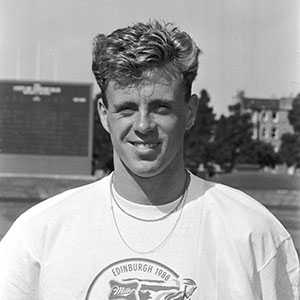
Having taken the decisions to concentrate completely on the coaching, the first thing Tommy Boyle had to do was map out the route that Tom had to take. Good coaches seldom coach for the current year, they are always looking ahead and Tommy was no different in that respect, but he was different in the detail as he went down the road to the future. The plan might need altered, tweaked or even changed but having a plan that can be changed is far better than having no plan. A look at how he structured the crucial Junior Man – second year senior man transition is perhaps instructive. The following is taken from Tommy’s report to the International Coaching Convention in Edinburgh.
Junior Man 17 – 19
Cross country is now seen only as conditioning with races as fitness tests or fun with the boys. Weights were introduced in the circuit format with the major training objective being the development of sprinting ability and refinement of technique aiming to significantly improve 200/400 metre times Which would be the limiting factor in subsequent specialisation at 800 metres if we recognise where the event is how going With Sebastian Coe t s world record l:41.73 (1:40 by 1990).
First Year Senior 19 – 20
The plan was to reduce his 200/400 metre times but with a shift in emphasis via the introduction of structured track training for 800 metres. However disaster struck when during a very cold spring, he increased intensity too quickly during the transition to track training. Result – shin problems – which, combined with a typical cavalier approach by a 19 year old, we had a bad injury which almost finished his athletics career through the sheer frustration of having trained hard all winter only to miss the full track season. Fortunately Tom Craig did an excellent job – gave Tommy one race where he finished second in the Scottish 800m championship. This kept him in the sport, but only just.
Second Year Senior 20
–The first objective was to consolidate the pre—injury performance and then to begin the next phase of development which was to specialise in the 800 metres event. Tommy was gradually introduced to increased workloads, training plans, short and long term objectives and gradually the process of transferring greater responsibility to the athlete was underway. major and minor objectives established and achieved — confidence in the coaching and training increased through realisation of goals discussion were now common with valuable feedback flowing in both directions. The year was concluded by introducing Tommy to a four year Plan, aimed at Edinburgh/Stuttgart and, as we were now half -way through having successfully achieved all objectives served the dual purpose of establishing confidence and presenting even greater challenges.”
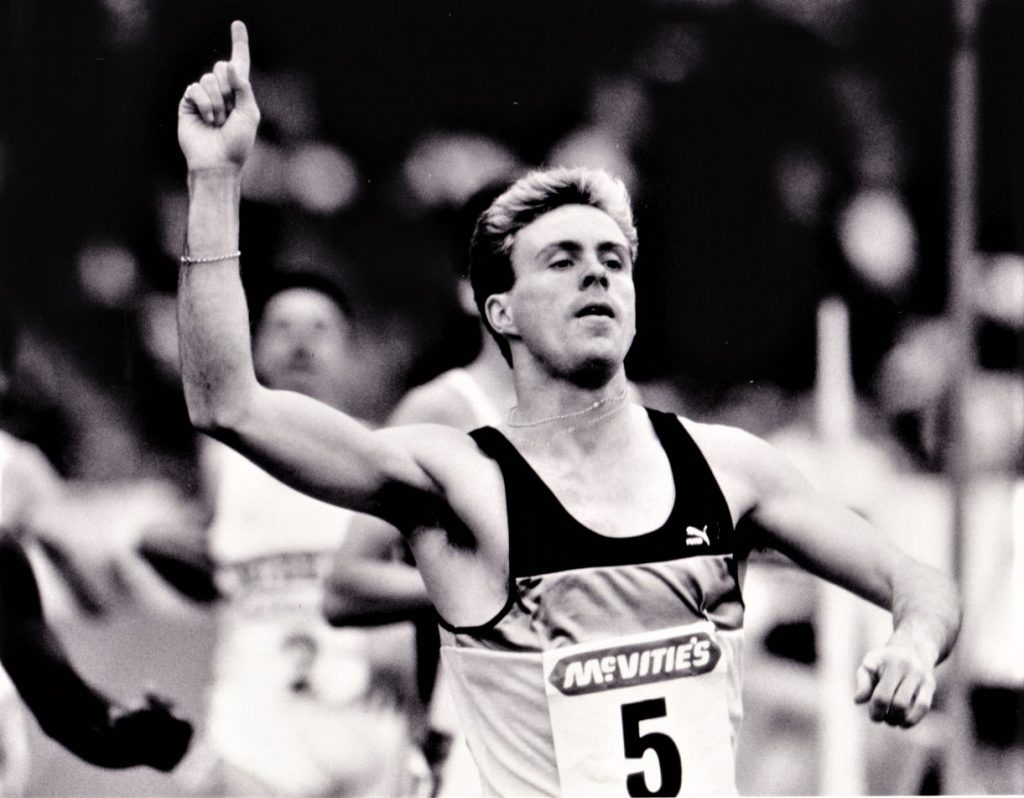
Tom wins against Paul Ereng: probably his best ever race: he won in 1:43.89.
Splits of 24.43, 50.14, 1:16.57 and 1:43.89:
https://www.youtube.com/watch?v=fxe3vKJDZmM
At this point we go back to the transition from coaching a domestic Scottish champion to working with an international class runner. We have seen that he had a problem with an injury as a first year senior that almost put him out of the game before he was properly in it. It was effectively dealt with by Tom Craig, highly respected physiotherapist whose day job was with Rangers FC and we will come back to that. However we have commented already on Tommy’s total honesty and he accepted responsibility for the injury. He was equally honest with Tom though –
“The increased free time, meeting girls, loss of the training discipline, resulted in the gradual realisation that he was not going to fulfil the promise which the previous year’s performances were suggesting he was capable of. I had a head on collision with Tommy where the hard facts were laid on the table: either 100% or nothing, and for some three months he messed about before eventually realising that he was throwing away the very thing he was good at.
As a coach I learned much from the situation:
(a) You can be the best in the world with the most talented athlete but unless he wants success more than anything else, forget it! You are wasting your time.
(b) The other harsh fact which emerged was the realities of our sport in Scotland: here we had another talented athlete out for a year and no one asked a single question why. It was a case of facing up to the facts and organising myself accordingly to ensure that I was suitably equipped to bridge the chasms in the system.”
The second fact above is worth looking at again. Tom had been injured and almost totally out of the sport in consequence. No one in authority in the sport had investigated the reason. Tommy had gone to Tom Craig, one of the best if not the best, physio in the West of Scotland. But Tom, however good he was and however well he communicated with patients, was not full time in athletics. He once told me when I took a Scottish international athlete to see him that if the athlete had been a football player, he could get him fit to play the following Saturday but …. and gave us some advice on exercises, treatment and how to approach track running in the near future. His priorities were not athletics and he was not immediately available. In addition it was the coach or athlete who had to foot the bill for treatment. If Tom were indeed going to tackle other world class athletes, there would be injuries serious and minor which would require immediate treatment from a quality physio or sports doctor.
Every good coach/athlete will conduct an objective review at the end of each competitive season. Tommy, true to form, conducted a more detailed (and debatably more honest) assessment at the end of 1985 season. Instinctively he knew that the apprenticeship was over for both, Tom was laying slabs in a youth employment scheme, not conducive to becoming a world class athlete, we had to be ruthless in our review, Tommy used his business skills and developed a model which he honed in future years. (See Susan Scott 2004/5, below)
The review led Tommy to several conclusions:
# Tom was now committed to the four-year plan;
# Tommy was confident he knows what is required to prepare a world class 800m athlete with Toms potential;
# He had to be able to train twice a day and be able to work part time;
# They needed to build a support team Physiologist/Physio /Podiatrist /Legal advice.
How could these requirements be achieved? For the breakthrough to world class competition, he needed a carefully crafted marketing plan. Having known Frank Dick, UK National Coach, for some time and sent him a call for help. Frank helped and between them they agreed the outline of a strategy for 1985. Tommy understood it was only a plan, however he took a pragmatic approach,: they had nothing to fear no one expected Tom to really do much more than he had – just another good age group potential.
Tommy later shared the plan with journalist Doug Gillon when the first part had been executed successfully and we were in the new frontiers phase daring to dream the plan (and subsequent results) was:
Open the season at Scottish YMCA champs 400 test the speed low key no pressure: result 1st in 48.0
Win UK closed 800m in Antrim – no one would expect Tom to be anywhere but he was 1st in 1.49.19
Andy Norman, Mr UK Athletics back then, was a no-nonsense ex-policeman from the South of England and a bit of a bully. Many athletes were a bit scared of him but he had the power to help or hinder an athlete’s career. He gave Tom his ticket home before the heats on Friday and told him “You will get a flight home to Glasgow tonight.” However the race didn’t go to script: Tom took David Sharp in the home straight to win. Suddenly everyone was asking who was this Scotsman? Tommy had prepared him well for the rough and tumble of a top 800m by training against top 400-man Ian Callander training pal from Bellshill YMCA: Doug Gillon refers to this in his comments on another page of this site. At this point we quote Tommy directly.
“Next up we convinced Andy to get Tom a race in Europe Madrid result where Tom was 1st in 1.47.7 – new PB
Absolutely key in the plan was to go head to head with Edinburgh’s Paul Forbes, by now a 1.45-man, tough competitor and coached by my pal Bill Walker from whom I had learned so much. Tom was again 1st in 1:53.4 massive confidence boost.
We had calculated correctly that this would get him selected for two internationals: the first was at Gateshead against Steve Cram it was a fantastic opportunity to make a name for himself and Tom seized it and was 1st in 1:47.25 for another new PB.
Next was the second international, critically again televised, and the result was another 1st in 1.47.1 – a PB -against Chris McGeorge (coached by George Gandy)
Tommy went on to say “ It is fantastic when a plan comes together, however we still had to have a bit of luck. This came in the form of Sally McNair,an upcoming TV Presenter, who did a fantastic piece on prime time news. Within 30 mins I had a call from car dealer Glen Henderson. He said he wanted to meet the coach,so I travelled down to Prestwick in my wee Ford Escort and met him in his big flash Mercedes Garage.
Glen asked the direct question: “What do you require to make this guy world class?” I replied that it would take a part time job, transport, financial assistance with medical support and help with travel to competitions in order to be independent from agents. He replied, ” I will support you both – provided Tom stays with you and you leave no stone unturned in the pursuit of world class performance.” Glen added “I will give you a week to find the top Physiologist and physiotherapist,”
I called Professor Myra Nimmo and she agreed to be part of the team. She also suggested that Dave McLean, physiology lecturer and exercise physiologist with the SRU would be a wise choice. We subsequently recruited Jim Black, podiatrist, a nutritionist and, as athletics was in middle of the transition to professionalism, we recruited lawyer Doug Whyte, ex athletics coach to look after trust funds. The team was in place by the end of the year and Glen agreed to a package of funding, valued around £ 40, 000.
He also advised on negotiation of a sports wear contract with Puma, a tough negotiation with Derek Ibbotson, Marketing Director and Olympic medallist. Derek became a great friend and eventually Puma sponsored both Tom and Yvonne. He was a great guy with a wealth of experience and was always willing to advise at major competitions, indeed he was in the warm up arena when Yvonne went on to win her bronze medal in Seoul Olympics against some rather suspect opposition which we shall discus later .
Next up was an unplanned race over 1000 m at Meadowbank . Tom did not run well and we both learned the hard lesson of competing at this level when you have not trained for 1km . The second half of the season was always going to be ‘in at the deep end’ and learn how to compete against the best on the circuit and vitally in televised races with good appearance money.”
The Competitions were:
| Venue |
Position |
time |
comments |
|---|
| IAC Crystal Palace |
second |
1:47.8 |
J Cruz 1st |
| Budapest |
second |
1:46.05 |
New pb |
| Europa Cup |
first |
1:49.05 |
very tactical race |
| Zurich B Race |
first |
1:46.28 |
massive learning experience |
| Berlin GP |
sixth |
1:46.09 |
Painful experience of back to back comps in same week |
Coaches always learn from every race their runners take part in and Tommy learned more about Tom, when he was exposed to the unknown. The race was in Cologne where he was first but it was at the end of a hard season and he was out of gas by then. Tommy had guided his protégé to “world class” – but, probably more important, he had developed a strategy to maximise the opportunity when it happened, securing a unique sponsorship package with Glen Henderson and building a support team which did not exist in Scotland at that time.
Tommy knew sports science could help them however the challenge was to find out how. This resulted in a whole programme of testing conducted on every session – OBLA every mile round the streets of Bellshill, then in the lab, lactate testing of circuits, power circuits and many challenging discussions on training load mix and recovery. Myra once asked Tommy why he was doing a session – he replied “Because I am the coach.” She immediately responded, “Why are you giving Tom this session ???” One of the biggest lessons Tommy learned.
The Team then reviewed Tommy’s next four-year plan, specifically the review of 1985 and the plan for a massive year in 1986 Commonwealth and Europeans within one month. Once again it was back to the process of critical review tackling the issues of Where are we now? What we learn — performances v plan, where are we going now? how will we get there?
Tommy reflected that the strategic plan was working, he had successfully navigated the athlete through the myriad of challenges which occur in every young athletes’ life. He remembers his observations at the time regarding the landscape in Scottish sport and specifically Athletics, there was no institute of sport, no real performance strategy ,a fact concealed by a group of willing volunteer coaches who tried manfully to promote specific events against a tide of mediocrity in the sport, I really admired these coaches who gave so much of their time in an attempt to improve the standard of coaching and performance across the country.I think they were given a very small fee to cover a massive task ! True heroes and legends of the sport . Tommy also discussed with Doug Gillon, a font of knowledge, how he had observed that almost without exception Scottish coaches and athletes who succeeded in reaching the highest performance levels in international athletics did it in spite of the system, they tended to work in small groups and just did their own thing- a critical success factor he had learned from the people in pro athletics who produced more top class sprinters than amateur athletics ever did. Tommy was smart enough to learn from this discussion and it only reinforced his belief in the strategy which he had developed ,do it your own way and becomes self sufficient
He remembers a discussion with Myra Nimmo who firmly believed that very soon sports science would become part of the support mechanism for top athletes,however we were in the then and now facing the unknown. Tommy knew he had little experience in the four year championship cycle, he was also painfully aware of the lack of real experience in Scotland . We can perhaps get a good insight into his thinking and how they approached the commonwealth games and European championship year by reading an extract from a lecture he later did LINK
Phase III – Fourth Year Senior 22
Careful analysis of the previous year’s situation clearly indicated that we had several flaws in our armoury. To reinforce these weak spots necessitated strengthening the support team. Fortunately, Tommy’s major sponsor, Glen Henderson, in addition to being a very successful motor dealer, was also a very knowledgeable sports enthusiast who specialised in speed skating and was able to advise in which direction we should move if we were to continue to progress in the cut and thrust arena of World Class athletics. This was gradually achieved by the recruitment of the best help which we could find: every aspect was improved.
Training workloads were increased in line with the requirements of three-round championships. Physiological testing was commenced to monitor the effect of present and past training and to provide a more accurate guidance of future training. Physiotherapy was made more readily available and this, as Glen Henderson had predicted, proved to be a crucial factor when Tommy was injured in three separate occasions but was still able to complete “safely” and “successfully”.
The objectives were established – competition plans compiled in such a manner that the minimum of exposure would obtain the desired effect – recognising the degree of expectancy which would inevitably exist and gather momentum leading up to the Commonwealth Games. Experiments were conducted in minor races, previous personal bests achieved but, importantly not surpassed, offers to run in major races were politely refused, the opposition and their ploys totally ignored as we became engrossed in the seemingly impossible task of getting Tommy through the injuries in the correct mental attitude. This was done and the final preparation for Edinburgh checked and re-checked by Stuart Hogg, long time friend and senior sprints coach. Nothing was left to chance in our quest for competitive advantage for the athlete – result: 2nd position – 1m44.80, new Scottish National/Native Record.
The next task was to overcome the vacuum created by the post Games anti-climax. This proved to be an even bigger problem than I had thought it would be and this is where the team approach really “proved its weight in silver”. Our solution to the problem was a total change in environment – training partners – coach – and, probably most important, to escape family pressures – a very high risk some might say but we prefer to think that the final week’s preparation in Glenrothes was a sensible response to a very difficult situation – result: Coe 1st, McKean 2nd, Cram 3rd – new Scottish Record – new PB.”
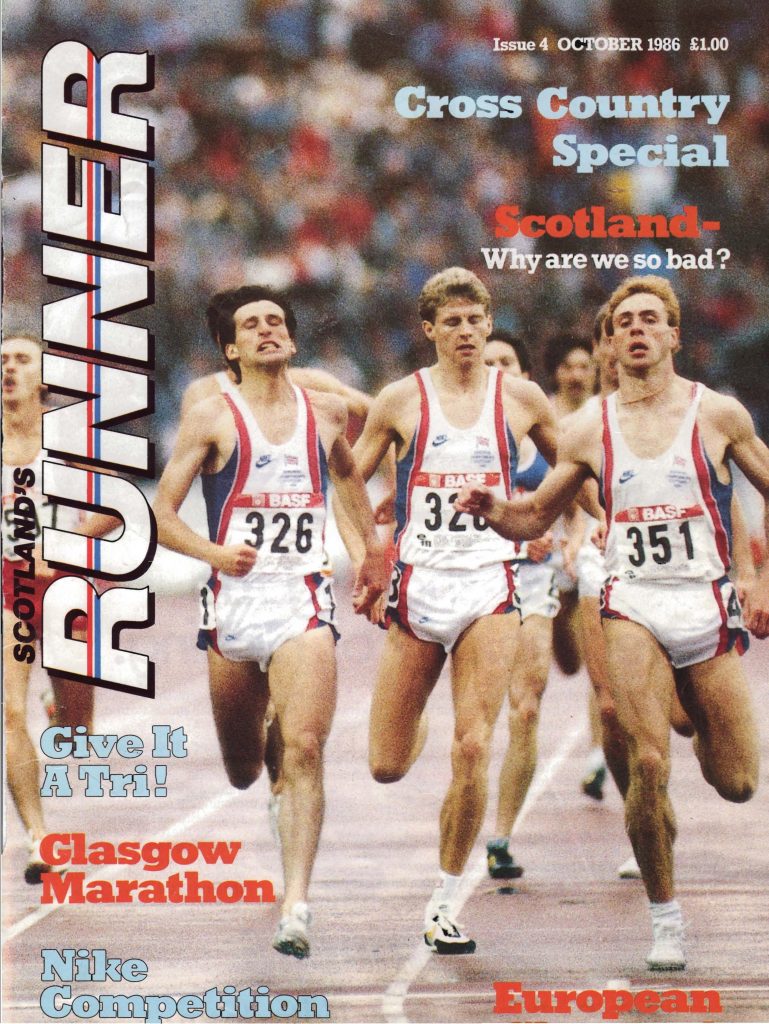
Glen Henderson was a very interesting person and had himself been a competitive sportsman. A motor dealer, motorcycle racer and speed skater he broke the quarter mile British speed skating record in 1954. He later became one of the largest motorcycle dealers in Scotland. A pupil at Ayr Academy, he left at 15 and opened a motorcycle repair shop in the town supported by his maternal grandmother Ann Aitken who even pawned her fridge to purchase fuel for her grandson’s racing bike. Glen won the Scottish Motorcycling Championships on the sands at St Andrews a year later. He went on to race at Brands Hatch, all the British racing circuits and all over Europe. He sustained a serious crash at Kirkcaldy and stopped racing for good and took to preparing racing bikes. One of his Honda motorcycles came second at the Monza circuit Grand Prix to the amazement of the Honda Factory Works Team who could not understand how a tiny workshop in Scotland could achieve such a result. When his close friend Bob McIntyre was killed, while racing, Mr Henderson gave up all his racing activities. He was also involved in speed skating: in 1954 he broke quarter mile British record. He went on to establish the Scottish Speed Skating Union and this involved developing a training programme for young promising speed skaters. This was so successful that several members set World and European records. So his interest in sport was not a new thing and his experience of competing internationally himself gave him an insight into what was required to do so effectively. In addition as a businessman he was direct in his approach. This was just what Tommy needed.
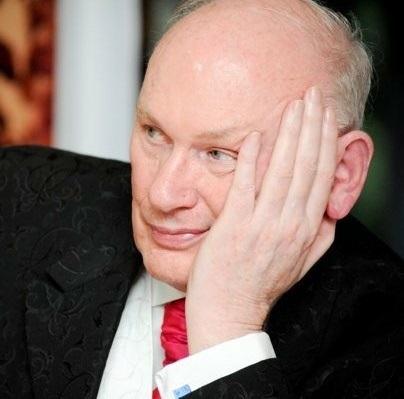
Glen Henderson
The dream of every coach who is fortunate enough to coach an athlete with potential, is to take them the full journey to the ultimate challenge in athletics the Worlds and Olympics, the Worlds were in Rome 1987 and the Olympic Games were in Seoul in 1988, Tommy was determined to ensure his protégé was provided with the very best opportunity to make this massive leap both in performance level .
Tommy reflected on the World preparation, saying, “the team were in place Tom appeared to be handling the increase in volume and intensity which would prepare him to run four rounds in sub 1.45 seconds which we anticipated. Early season racing went well he won the Europa Cup for a second time and had a few other competitions including the UK trials. I remember Derek Ibbotson sharing a piece of his hard-earned experience, he said you can only get experience of competing in these races by doing it, you may be fortunate, but many athletes require one full cycle to learn how to handle the external pressure – Tommy and Tom were later to reflect just how wise these words were!”
Tom navigated the first three rounds in a spectacular manner attracting a great deal of media attention and expectation. Tommy remembers the hype and how Tom was sweating profusely in the warm up area a new experience, the call room to track was a long process and then the athletes were held on the track for a very long time, another first experience. The race was brutal: the Kenyans had a plan, very well executed – one athlete (Mara) ran on Tom’s shoulder, he was boxed in for 450 metres and then just as the gap opened he tripped on Peter Elliot’s legs in what was to date the fastest race of his life and for the first time in his career he appeared to be lost. He was devastated, finished last and coach Tommy noted a weakness which perhaps would define Toms world level career. Tommy was later to hear his Mentor at Winning Scotland Foundation, Sir Bill Gammell, repeating the statement “it’s the ability to think fast under pressure which separates the truly greats in sport and life “ However the greatest surprise was the manner in which the British press crucified Tom as a coward. It was shocking and Tommy told a few of them that they should hang their heads in shame, however Tom was scarred by what the press said .
Coach Boyle himself learned the big lesson that “it is in failure that athletes really require a coach to support them in navigating the mental minefield of focusing on the learning from any life lesson”. Tommy remembers his dad’s advice when he fell of his bike in an accident with a bus, “he said get back on now and go for a long run on the road with traffic”. Tommy discussed with sponsor Glen Henderson and they agreed Tom should not only race but chase the winner of the worlds – Billy Konchella – and take him on head to head to bury part of the scar. He did and beat him three times before the season finished including a great pb in Lausanne. He says, “We were later to learn the surface scars healed quickly however Tom had personal issues in his relationship with his long-term girl friend and went of the rails a bit in the winter, visiting night clubs in Glasgow a mistake which would come back and bite hard at the moment of greatest pressure – The Olympic Games.”
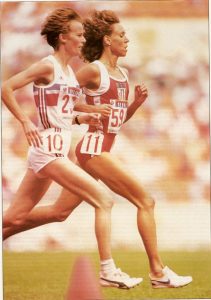
Tommy was asked to coach Yvonne Murray (4th October 1964) in October, 1987. She was already a considerably good athlete who had been third in the 1986 Commonwealth Games 3000 and in August 1987 had finished third, this time at the European Championships in Stuttgart, in a time that would have won gold in Edinburgh. She had fastest indoors times by a Scot for 800m, 1500m, 3000m and two miles; she had outdoor records at 1500m (both native and national), 1 mile (Native and national), 2000m national, 3000, (native and national) and in 1987 in the world rankings she was 9th for 1000m, 6th for the mile, 2nd for 2000m and 7th for 3000m. It is not an easy task being asked to coach a runner of that calibre and improve that athlete’s performances. Tommy wasn’t the first Scottish coach to have this challenge: there was an article in World Sports magazine about John Robson changing coaches with the new coach saying that John was a great runner, he would make him a great champion. No word of it being a challenge, he would make John a great champion. Several months later, deep inside the magazine was a quote from John saying that the toughest thing he ever had to do was ask his old coach to take him back!
It was at the end of the 1987 season that Tommy was asked to take on coaching Yvonne Murray and he remembers advising Yvonne to go back and talk her coach. However she said it was over and wanted to move on. Tommy remembers I knew little about preparing a world class athlete for 3000 metres, but we had a fantastic professional support team in place and I knew from what I saw that we could improve Yvonne Murray.
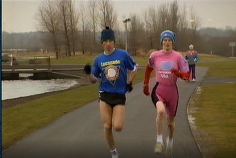 Tommy coaching Yvonne and Stuart Gibson doing 1000 reps at Strathclyde Park
Tommy coaching Yvonne and Stuart Gibson doing 1000 reps at Strathclyde Park
“It was back to the drawing board. We used the tried and tested strategy,” understand the event requirements, evaluate the athlete’s status and then establish short medium- and long-term plans to ensure the athlete was gradually developed to compete to win at world level”
I remember contacting the BBC and requesting copies of videos of previous competitions, followed by long hours studying her races, identifying her strengths and weaknesses, we embarked on a full physiological screening programme to objectively assess the athlete, Myra Nimmo was awesome and could relate well to Yvonne having been on the journey as a female athlete herself. We only had one year before the Seoul Olympics. We took a few risks in our planning – cut her mileage in half, focused on quality as she already had a massive engine with a very low heart rate (which we had checked thoroughly) Stuart Hogg agreed to work on Yvonne’s leg speed and over that winter she spent most Saturdays in Glenrothes doing sprints, long intervals and circuits at night, Myra, Dave and I focused on the quality of her running utilising the OBLA runs, weights and circuits to ensure Yvonne was physically capable of sprinting from a long way out.
However, it was probably the combined effects of the total support package, leveraging off our success with Tom McKean, we negotiated a sponsorship with Glen Henderson, part time job and car combined with a shoe contract with Puma Yvonne was furnished with all the physiological back up which provided that critical confidence that what she was doing was working and she could confidently go for the win.”
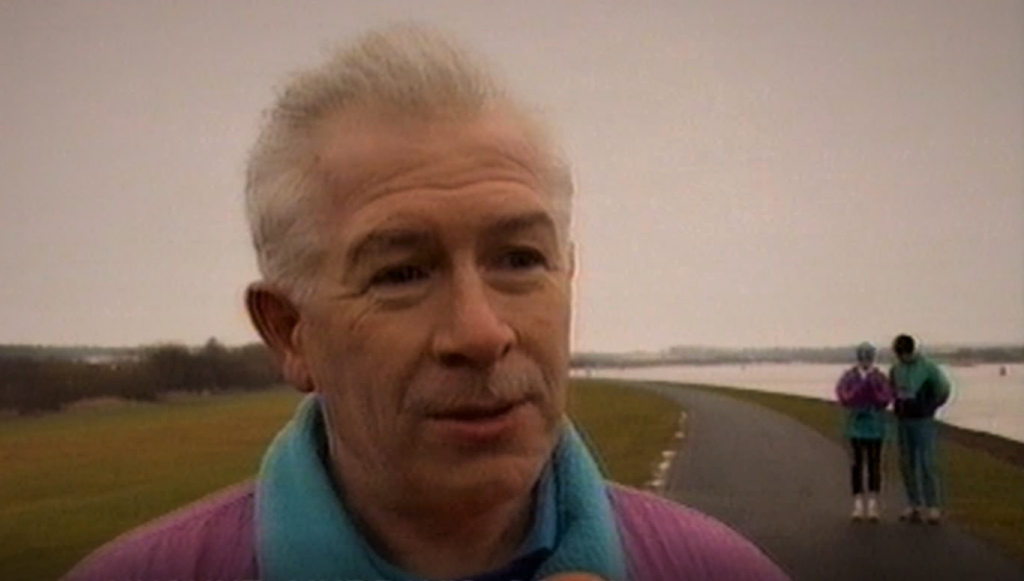
Tommy now had two athletes in prep for the Olympics. Tom had a big fright at the UK trials when Martin Steel, a low level 800 athlete went through in a 48. sec first lap, Tom chose to go with it. However at 700m the wheels came off, swimming in lactate he just managed to hold off the fast finishing Steve Heard to gain the qualifying place with Steve Cram in first place. Tom again: I remember that night in the bar Doug Gillon did his usual ferreting and learned that Martin had been asked to go though fast with a view to taking Tom out – I wonder who would benefit? Martin and ??
Next experience for Coach Tommy was a week before the team flew out to Japan, being confronted by the Sun newspaper saying they had dirt on Tom. He had been stung by a kiss and tell girl: in the winter of 87/88 he met a girl in a Glasgow night club, had a short relationship and made the big mistake of going back to the club in the summer where he was duly ambushed for a picture. “I met the rats and told them they were vermin, however they said they would print the story on the day the team left the UK, I called Doug and Alex Cameron for advice. We agreed to get a counter story in the record with a picture of Tom and Yvonne with his fiancé however the damage was done. You can imagine the row in the McKean family and how and where his head was as he met the team,all the boys giving him the big ra ra as he boarded the plane for the Olympics in Seoul.
Combined with this Yvonne Murray had a big shock incurring a bursar in her hip just three weeks before flying out Tommy and Dave took the gamble got top SRU surgeon to inject, with the result we were able to quickly accelerate training and Yvonne was set for her big dream .
The Olympics was a massive challenge for the team, Seoul was at the other side of the earth. High temperature high humidity with big security issues for UK and USA teams, . I remember long team meetings throughout the winter adapting Yvonne’s training to maximise improvements ,planning every detail of the trip which would involve a holding camp in Japan, it was an up market country club with over three hundred army personnel guarding the perimeter, with the UK and US teams confined to the camp .
Tommy and Stuart had a massive challenge now disaster recovery, with Tom’s head back in Bellshill, Yvonne still lacking the confidence to push those vital 300m reps, OBLAs had to be done through the village with the coaches pedalling frantically to avoid traffic and keep up with Yvonne. Once again, all the hard graft paid off and I utilised every ounce of my experience to get our two proteges to the start line ready to perform. Tom did a 600-time trial in 74 sec he was ready Physically!!!
The prep had been done, it was over to the athletes. Tom was in excellent physical condition,but in the second round he was in another world and woke up in sixth place with 90m to go, he pushed his way through to the qualifying position only to be disqualified after a protest by Holland. That was a long hour, indeed a long journey home for him and he disappeared from the radar for a few months to recover his relationships back home .
What an experience the whole competition day was for Tommy, Yvonne and support team; she qualified easily for the final, which was loaded with world class athletes and many who were suspected of taking illegal substances. Tommy reflects “drugs were a massive problem at that time especially female athletes from the eastern bloc. Derek Ibbotson was with us in the warm up arena, it was intense, however with his usual Yorkshire wit Derek said did you see that Tommy I said what? Paula Ivan going into the porta loo with her bag, He instinctively started his watch, the time ticked by, this was minutes before these athletes were to run the biggest competition of their lives. Time went on. Yvonne was buzzing to go, we observed it was 13 minutes before Ivan emerged It was a fantastic race third fastest of all time, but Yvonne was in awesome condition, see the race here . The result:
1st Tetyana Samalenco later known as (Tetyana Doroski and not found positive until 1993 and a load of medals later)
2ND Paula Ivan Romanian with mysterious background who disappeared from the scene shortly after??
3RD Yvonne Murray 8.29 smashed her pb and in my opinion cheated out of an Olympic Gold.
Tommy went on, “this was a fantastic example of what could be done with a talented athlete with the requisite support in place and done in Scotland without the use of performance enhancing drugs.”
However ever the perfectionist Tommy noted after a study of the video of the race that the habit of looking round at 200m was still there, work to be done in the learning process perhaps an extract from a lecture in 2005 gives us a short insight into the 1989 season. Tommy says:
I had to teach Yvonne to believe in herself and learn to be ruthless in the pursuit to WIN.
The ultimate challenge for any coach is standing tall with your athlete in adversity and I had been taught this all my life at home, in sport and at work, now was the time to find out how much I had learned and if I could help Tom return from disaster. I knew how good Tom was and firmly believed he could do much better and win titles and subsequently spent a great deal of time convincing the sponsors to stay with him which they did !
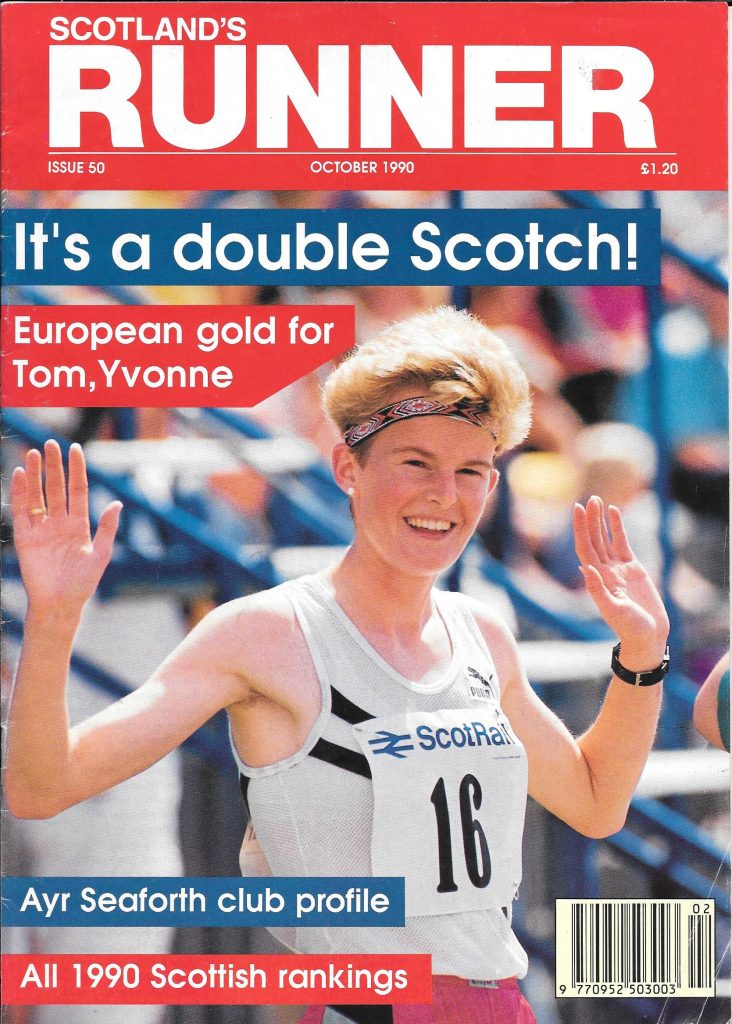
1989 for both athletes the winter consisted of consolidation of the training regime which we had implemented.
• Increasing load – reducing recovery/increasing intensity
• Improving every aspect of technique – circuits/weights/running
• Construction of a competition programme which would ensure the athletes had the opportunity to learn from previous mistakes and learn to win at championships.
• Lifestyle balance was again improved with every aspect scrutinised and corrective actions implemented
The plan for Yvonne had two major objectives – teaching her to change pace of speed and sending mis-information to her rivals, I discussed with her how to beat female drug athletes, what will frighten them – she replied no female enjoys going from way out in a 3k -THE AHA moment.
The plan with Tom was straight forward: just convince him how good he was and train harder than ever before and race harder to build his confidence especially against the Kenyans
During the complete season I spent three weeks on the European circuit with Tom and Yvonne learning how they coped with the situations and each other this was to prove a very valuable experience in preparing for the Commonwealth Games Europeans indoors and European outdoors in 1990 – result was an extremely successful competition season with many fine performances
Tommy was quoted as saying ‘these were two of the best years I spent with Tom and Yvonne. All the hard work was paying off we were a great team at that point it was one of those magical parts on all of our journeys through life’
The highlights Tommy remembers being for Tom –
• Increase in exposure to Grand Prix Competition with very fast first laps.
• Taking on the best in the world week after week.
• Front running the Scottish Championships and new Native Record 1:44.79 at Crown Point.
• Chasing and beating Paul Ereng (Olympic Champion) unbeaten over 20 races in one of the best races of his career (1:43.9 – Scottish National Record at Crystal Palace)
• Winning the Grand Prix Final
• Finishing Top world rank at 800m in the world.
Highlights Tommy remembers for Yvonne were
• Grand Prix Final Kick at 200m (Gold) – 9:02.59 3k
• World Cup Final Kick at 800 (Gold) – 8:44.34 3k
• First British Winner of Women’s Track Event at World Cup Final.
• Ranked no 3 in the world at 3000m
• Critically no one knew where Yvonne would kick from in a competition.
Tommy remembers remarking to Glen Henderson in their annual review, “Glen I feel we are on the cusp of big things with these two athletes” little knowing that Glen was under sever financial pressure because he had invested so much in building a speed skating arena in Prestwick and their sponsorship would soon end. Coach Tommy was right. 1990 proved to be a fantastic year for the athletes and the team. He reflects that it was “the culmination of years of hard graft by everyone involved the strategic planning, the massive research, focusing on mastery coaching versus short term win at all costs, yes it was tough especially with a load of critics in Scotland. We were all still learning what this level was all about 1990 posed numerous challenges perhaps best explained in a lecture link?”
1990 – Phase IV – Winning at World Class Level
The objective was to develop a double periodised competition plan aimed at preparing an athlete to compete in the Commonwealth Games in Auckland, New Zealand in January followed by European indoors Glasgow for Tom with a second competition phase aimed at winning the European 800 and 3000 in Split Yugoslavia in August. The challenges were immense, and included: –
• Further refinement of all training loads;
• Meticulous planning of double periodised year;
• Travel – accommodation – medical – physio – communication;
• Pre-Games training camp in Australia then travel to Auckland
• Coach support in Auckland – T Boyle/S Hogg;
• Competition opportunity limited 1 Comp each – Result Silver for Tom in relay and silver for Yvonne in the 3000
• Tom transition back to indoors prepare to win Europeans in Glasgow which he won!
• Yvonne transition back into volume training in Scotland.
The main Competition phase was the European Champs. Preparation consisted of :-
• Meticulous planning of load intensity;
• Thorough evaluation of competition;
• Competition season designed to create picture in opposition mind;
• Final preparation – in warm up area –
• Convincing Tom to run from the front to win
• Reassuring Yvonne that she could out kick the drug athletes by going from long way out
• And as it transpired staying focused in warm up knowing Tom McKean had just won Gold!
• Result both Scots won Gold a massive result for everyone involved.
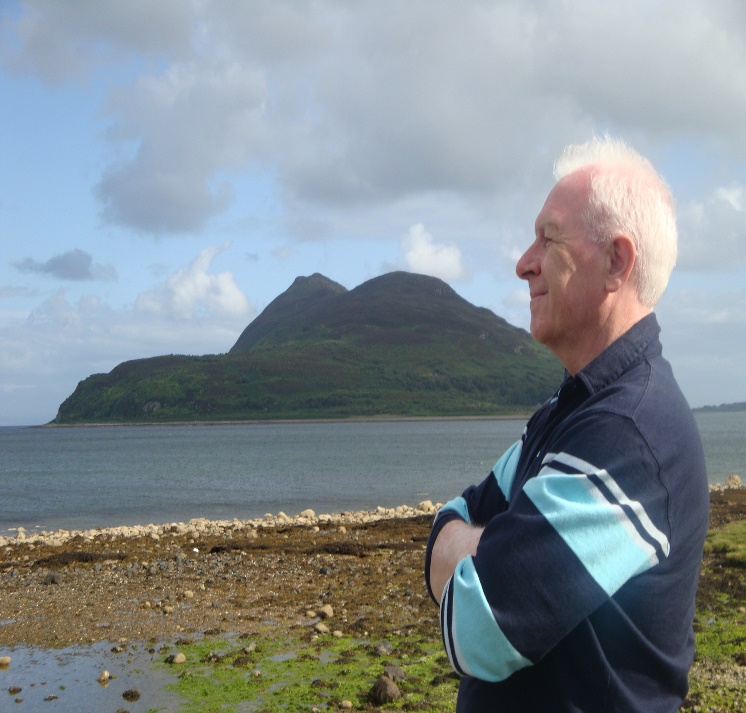
Coach Tommy was now in big demand he remembers requests to lecture all over the globe, numerous athletes requesting to join the squad, However as Tommy says I had proved to myself, I could coach athletes in different events to become the very best they could be , the strategy had been proven and training methodology tested to its max, I was not a massive EGO guy ,and was more interested in coaching Tom and Yvonne in the final stages of their athletics journey and leveraging off these results to help the local athletes ,club and hopefully to better promote the development of athletics in Motherwell and North Lanarkshire and I did just that over the next few years .
Securing sponsorship from Smith Clyne Beecham –(for Lucozade product for the athletes and the club ) we used this to provide every child with a can of Lucozade in every schools cross country and Tom and Yvonne would be there to present awards these events were massive and grew until we had 90 % of primary and secondary schools competing with thousands of young people introduced to the sport Tommy said I found the success we had achieved opened doors and I was determined to leverage the opportunity to its max .
I always did one lecture at the start of each year just to sharpen my thoughts and refresh ideas therefore I agreed to do the European Coaches Congress in Finland ,not knowing that Frank would ask me to do two lectures -wow that was a challenge with loads of interpreters over 150 delegates from across the globe ,it went down well and I received the coach of the coaches award -it was nice to be recognised by your peers .
I remember after I had finished my second lecture, which was emphasising the scientific approach with pulse monitors, lactate analysis and stuff like that, Gordon Surtees, a great friend, came on and opened with the statement, ”I have never used a pulse monitor or lactate analysis in my life.” A MAGIC MOMENT FOR COACHES AND LESSONS THAT EVERY ATHLETE IS A PROJECT AND THERE ARE MANY WAYS TO ACHIEVE THE SAME END GOAL !
Tommy still had unfinished business supporting Tom and Yvonne. Glen Henderson had business challenges and had to withdraw his sponsorship Coach Tommy and Jessie Hill Tommy’s PA (who was now looking after most of the athlete’s administration issues) went into overdrive to recover the situation, digging deep into their business experience they secured a sponsorship with Giltron Office Supplies for Tommy and with Scottish Equitable for Yvonne.
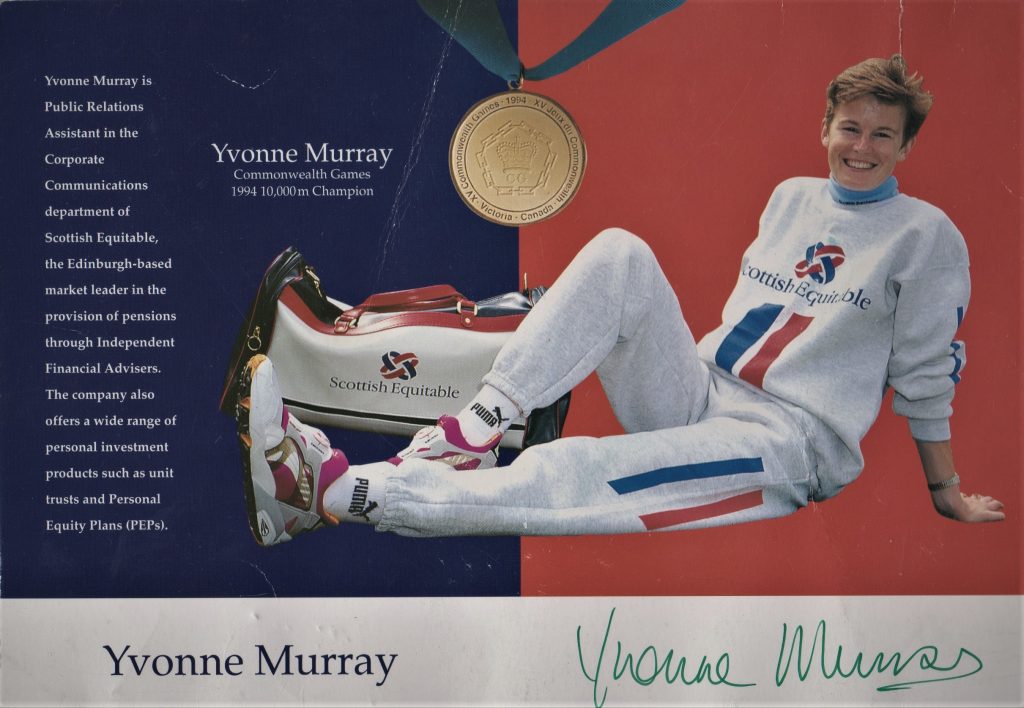
Puma also pulled the plug on Tom’s contract as Derek Ibbotson was replaced as Marketing Director. Once again we were proactive and negotiated a contract with New Balance for both Tom and Yvonne I think the headline poster was “The New Balance of Power “with a picture of Tom and Yvonne winning the Europeans .Many people have asked why we kept things so tight as a team ,indeed why we provided so much support for the athletes , Perhaps Sir Bill Gammell defined Tommy more accurately than most when he said “Tommy is one of the few people who have real vision, can see the big picture, but also has that unique ability to be able to translate vision into a strategy and then implement practical solutions to big challenges .”
Tommy reflects, “I had loads of critical comments regarding the way I coached, the way I managed the athletes, the way we trained, indeed just about everything we did, however that is what happens in a small nation when you become successful load of “experts” keen to knock you down!
Fortunately, I had been brought up the hard way, family of 11 children, no money, we learned the true meaning of G.R.I.T. very early as had Tom and Yvonne.”
Tommy added “history has proven we were ahead of our time recognising that to succeed at world level athletes would require to become professional and be supported in a professional manner, as is now the case in most sports I guess we were trail blazers in our approach “
Tommy moved to Livingston with Honeywell Computers into a very demanding production management position, so his time was now being stretched even more, Business demands increasing
Coaching and managing world class athletes who depended on athletics to earn their living, supporting the development of local athletics made it inevitable that something had to give and Tommy ended up in hospital – a sharp warning .However he had already moved to what he calls the reflective stage in coaching athletes, that is where you listen to the athletes and just reflect back on what they say and think, maybe adding a wee bit advice on the way, indeed Tom and Yvonne and the athletics squad were actually out in Portugal on warm weather training when he landed in hospital so the final stage of the process had begun .
1991 was World Championships year and Yvonne was asked what she wanted to do. She said she’d like to try altitude training; so Tommy did his usual in depth research and preparation, Myra contacted Tim Noakes, Yvonne contacted Margaret Strang, mother of Internationalist David who was part of the 4 x 400 silver medal team in Auckland, 1990. Tommy planned his holidays so that he could go out to Johannesburg for three weeks with his son Mark to support Yvonne. Then it was down to sea level for a few weeks. Physiological testing was coordinated by Myra and Tim Noakes .
Tommy remembers “I was shocked when I met Yvonne at the track in Stellenbosch – she was very emotional, I knew something was not right -too much work on her own – however we pulled it together did some great work and then Yvonne went back to altitude for the second phase.
Did it work? Tommy says they learned loads however, with hindsight world championships year was not the time to experiment, – “hindsight is a fantastic thing!” he says, before looking at what was ahead..
1991 The main competition season for Yvonne:
- Major mistake in Europa Cup, Frankfurt when we decided to experiment with Yvonne going after one lap. She went too fast on that first two laps and really suffered. Therefore, it was an experiment which backfired in the HEAT! Tommy was now increasingly aware of the challenges for Yvonne running in high heat and humidity her body did not handle it well and she did not perform to her capability despite loads of preparation .he remembers long discussions with Myra and loads of research mainly into the knowledge gained by the army, they concluded that to see real adaptation Yvonne would need to be in heat and humidity for around six months ,just not an option we had to make the best of it and perhaps be more selective however the worlds were in Tokyo and Olympics in Barcelona both hot and humid ????
- Quickly back on course with good victory at Meadowbank in 8:36.05;Tommy remembers that one well “What a competition that was against Liz . I had told Yvonne to give Liz utmost respect and run inside her vest, which she took literally and as she had poor spatial judgement due to an impairment in her left eye she bumped into Liz repeatedly. it was a brilliant run by Yvonne, however when they finished Liz gave me an awful glare ,when in reality I was paying her the highest respect a coach can give an athlete .
- https://www.youtube.com/watch?v=mGuzEhCgDi0
- The Worlds was always going to be tough on the back of beating the Russian in 1990 we prepared Yvonne as best we possibly could, used a treadmill in a local authority greenhouse in East Lothian to try to help acclimatise to the heat and humidity
- The race went well but I could see Yvonne was over heating and she knew it, she went a wee bit early given how she felt and could not go with the pace of the two Russians, one of whom would later be found positive for drugs.
As for Tom in 1991:
- Fourth European Cup Win
- Major wins in Europe on the circuit
- Worlds made a Minor mistake, in what was a brutal qualification first time we had experienced it one person through in each heat Tom misjudged his run on the home straight against 400m specialist Mark Everett, yes it was a long journey home.
A year later and in 1992 the Boyle camp was focused on the Olympics in Barcelona
Yvonne
- The year was focused at preparation for the Olympics
- Main competition season went well – most objectives achieved
- Major issue was trying to overcome the acclimatisation to heat
- Result Olympics – did not perform to capability in the conditions.
- With hindsight Yvonne once again did not compete well in high heat and high humidity. we must accept and move on to other challenges.
Tom
- Tommy remembers that yet again he had to dig deep use every ounce of coaching experience to support Tom in rebuilding his confidence after 1991 however Tommy sensed the athlete was not totally focused or confident in his own ability, once again we got Tom into fantastic shape.
- Tom had Major wins in Grand Prix circuit that year.
- Tom then qualified for Olympics however Tommy remembers well that in the warm up area he asked me to take a picture on his new camera, his priorities had shifted, and Coach Tommy knew it!
- Tom ran poor race tactically -no excuses he did not perform well and Tommy new it was getting near the end of their relationship.
Tommy reflects, “I knew we were reaching the final stage of the coaching journey with Tom, however I decided to give it one more effort with Tom and go for the world indoors in 1993, Coach Tommy did his usual thorough in depth research and decided to really put the ball in the athletes court, he called Meg Ritchie -Yes discus Olympian now strength and conditioning coach in the US and a good friend of Stuart Hogg .”
What a decision this was for Tommy. He sent his athletes out to Meg in Tucson Arizona 5000 feet above sea level.
Tommy had done all the spade work, everything was set up Meg was astounded at the level of performance of both athletes. She called Tommy just before Tom was about to leave for the world indoors and told him that Yvonne wanted a word. Yvonne announced that she wanted to run the world indoors: this was totally unplanned – a big WOW moment for Tommy!
Meg explained that the positive environment with massive football guys in the gym giving it the big positive vibes to Yvonne every day had a massive impact. Yes, it was a tough decision but that this was the reflective stage of the coaching journey. Tommy knew he had to let the athletes take ownership and they did both now going into the world indoors full of the positive vibes and in excellent condition Tom having just run a pb over 600m of 73.4 sec –
Coach Boyle was now in uncharted territory and he was once more doing what few other coaches are brave enough to do, give the athletes total control and learning to live with the consequences they would require in their future lives.
Tommy remembers that many people thought he smothered the athletes, however as we are seeing now this was a long way from the reality. He says “my coaching philosophy was all about producing Better Athletes and Better People and preparing them for the next stage in their journey through life – not sure the athletes understood or ever appreciated that and how hard that is to do -when you have to stand back and let them learn from making mistakes and learn life lessons from that process .”
Tommy went on to discusss a great believer in Mastery Coaching which is Developing the Athlete and the Person, Physiologically -Psychologically – Socially
*
WORLD INDOORS 1993. 800m Result: Tom McKean Gold 1.47.29
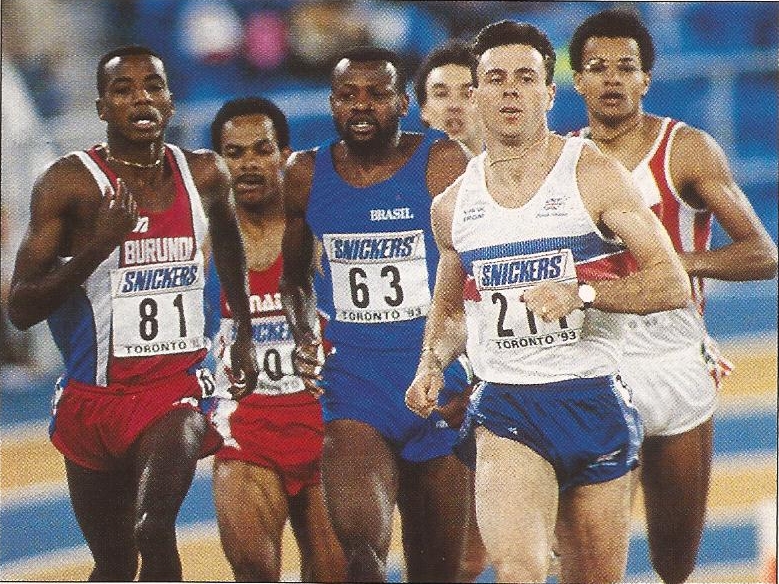
https://www.youtube.com/watch?v=Q_ZE9SrDs-I
At this point it might be said that Tommy had been very shrewd in the way he supported Tom knowing as he did that the end of their very successful partnership was looming.
Coach Boyle had taken a massive calculated risk in adapting his approach to majors for both athletes Tommy refers to learning from Gestalt – which he had successfully utilised in business, basically you cause a bit of disruption and humans have a fantastic way of reorganising and re-establishing order and these athletes certainly did quotes Tommy. However he was painfully aware you cannot use very often !
WORLD INDOORS 1993 Result Yvonne Murray Gold 8.50.55

Tommy saw less of Tom upon his return. He says of that time “Toms head was in another place. He was spending more time with pals on the golf course, listening to their advice. Then one day he came up to me at the track, when I was surrounded by a group of young athletes and announced he was moving on. I was very disappointed, not by the fact which I knew was inevitable but by the manner in which he did it – yes I was not impressed ,
Unfortunately for Tom, he like many sports people who try to change the successful recipe, find it is not that simple and Tom’s performances were never the same again and he retired from the sport in my opinion far too early as he was actually a late developer who had never missed a major competition through injury it was also at that time that a chasm appeared in UK Middle distance as the stars gradually retired
Tommy says he was very proud of the fantastic journey they had had together. “We travelled a long and successful journey a club coach from Bellshill YMCA and a young boy from a deprived background in Viewpark to the heady heights of world class competition and inspiring thousands of young Scots on the way.” Tommy remembers one old worthy from his home village of Newarthill saying ,”Tommy you did a fantastic job, McKean was a magnificent athlete and Scotland loved watching him on telly because you never knew what he would do, but it was always exciting. Aye well done the wee lad from 15th Motherwell BB”
17. Reality is Tommy and Tom had one of the most successful coach /athlete partnerships ever in Scotland from boy to man and spanning 16 years as we can see from this chart which details selected highlights of the journey.
| |
|
Age
|
Year / Date |
PB |
Event |
Psn |
Time |
| |
200 |
800 |
| Phase IV |
|
29 |
‘93 |
|
|
World Indoor Gold |
1st |
1:47.29 |
| |
28 |
‘92 |
|
|
GP Final (Bronze) |
3rd |
1:46.06 |
| |
|
|
|
1:44.39 |
Cologne GP |
3rd |
1:44.39 |
| |
27 |
‘91 |
|
1:44.20 |
Malmo GP |
2nd |
1:44.20 |
| |
|
|
|
|
Stockholm GP |
1st |
1:44.41 |
| |
|
|
|
|
Europa Cup (Gold) |
1st |
1:45.60 |
| |
26 |
‘90 |
|
1:44.76 |
European Champs (Gold) |
1st |
1:44.76 |
| |
Example of a Competition Year |
14/9/90 |
|
|
Sheffield |
1st |
1:46.50 |
| |
9/9/90 |
|
|
Rietie |
2nd |
|
| |
29/8/90 |
|
Peak |
Split |
1st |
1:44.70 |
| |
17/8/05 |
|
|
Gateshead |
1st |
1:45.50 |
| |
7/8/05 |
|
|
Malmo |
1st |
1:45.30 |
| |
4/8/90 |
|
1:44.44 |
AAAs – Trials |
2nd |
1:44.44 |
| |
20/7/90 |
|
|
Crystal Palace |
4th |
1:45.15 |
| |
12/7/90 |
|
|
Lausanne |
1st |
1:45.67 |
| |
6/7/90 |
|
|
Edinburgh |
1st |
1:44.96 |
| |
2/7/90 |
|
|
Stockholm |
2nd |
1:45.75 |
| |
29/6/90 |
|
|
GB v GDR v Canada |
1st |
1:46.98 |
| |
1/90 |
|
|
C Games Auckland |
|
|
| |
2/90 |
|
|
UK |
|
|
| |
2/90 |
|
|
AAAs Birmingham |
1st |
1:46.90 |
| |
3/90 |
|
|
European Indoor Champ (Gold) |
1st |
1:46.22 |
| |
25 |
‘89 |
|
|
World Cup (Kiproketch) (Gold) |
1st |
1:44.95 |
| |
|
|
|
|
Zurich Champs |
5th |
1:44.20 |
| |
|
Scottish Native |
|
Crown Point (Gold) |
1st |
1:44.79 |
| |
|
Scot. Nat. Record |
1:43.88 |
London GP – “Erang” |
1st |
1:43.88 |
| |
|
|
|
|
European Cup (Gold) |
1st |
1:46.94 |
| Phase III |
|
24 |
‘88 |
|
|
Olympic Games H2 Disq. |
Personal Issues |
| |
|
|
|
|
GP Final |
1st |
1:47.60 |
| |
|
|
|
|
1st 800 IAAF Ranking |
|
|
| |
23 |
‘87 |
|
1:44.45 |
World Champ Final 8th |
Media Expectation |
| |
|
|
|
|
Europa Cup (Gold) |
1st |
1:45.96 |
| |
|
|
|
|
Luagana GP – “Konchela” |
1st |
1:44.45 |
| |
22 |
‘86 |
|
1:44.61 |
European Champ (Silver) |
2nd |
1:44.61 |
| |
|
|
|
1:44.80 |
Commonwealth (Silver) |
2nd |
1:44.80 |
| |
21 |
‘85 |
21.60 |
1:46.05 |
Budapest GP |
2nd |
1:46.05 |
| |
|
|
|
|
Europa Cup (Gold) |
1st |
1:49.11 |
| |
|
|
|
|
UK Champs (Gold) |
1st |
1:49.12 |
| Phase II |
|
20 |
‘84 |
22.38 |
1:48.04 |
Scot Cat. |
1st |
Scottish International |
| |
19 |
‘83 |
22.40 |
1:49.80 |
Scottish Champs |
2nd |
1:49.18 |
| |
|
|
|
|
Injured – shins |
|
|
| |
18 |
‘82 |
22.80 |
1:49.30 |
Scottish Champs 400 |
1st |
1:49.30 |
| |
|
|
|
|
8 Nations |
1st |
Exposure |
| |
17 |
‘81 |
22.90 |
1:52.60 |
W. Dist. 800 |
1st |
|
| |
|
|
|
|
Scottish Junior 400 |
1st |
|
| Phase I |
|
16 |
‘80 |
23.50 |
1:54.10 |
British School 800 |
1st |
|
| |
|
|
|
|
W. Dist. 200 |
1st |
|
| |
15 |
‘79 |
24.00 |
1:59.70 |
British School Cross Country |
16th |
|
| |
14 |
‘78 |
24.50 |
2:08.00 |
Scottish School Cross Country |
4th |
|
| |
13 |
‘77 |
25.70 |
– |
School and Club Competition |
|
|
Coach Tommy Boyle still had unfinished business in supporting Yvonne Murray, through the rebuilding process into her 1993 season, Tommy was already planning for the next phase, fully aware of the changing landscape in the 3000 metres event, the increasing numbers of athletes being found positive for drugs, and the reality that all training takes its toll on the Physical and Mental wellbeing of an athlete .What was his thinking on this . Tommy reflects I spoke to Dave and Myra ,we agreed it was, see this season through then move towards the 10K for the Commonwealth Games in Canada 1994,then shift to road running as we knew Yvonne had biomechanical issues which would prevent her from continuing on the track .Tommy was also aware of his responsibility to tackle the issue of de-training with an endurance athlete like Yvonne a conversation he did not look forward to, knowing how emotional Yvonne was about her running career.
Tommy discussed the plan for 1993 and 1994 with Yvonne and she committed 100% to the shift in emphasis with the result her confidence grew every week in training and Coach Tommy guided her through a very successful season, with the introduction of road racing at Aberdeen, where she finished second.
1993 “Great when a plan comes together”
| 8:41.59 |
GP Final |
2nd |
| 5.36.03 |
Sheffield GP |
1st |
| 8:32.43
|
Brussels GP |
2nd |
| 8:33.62 |
London GP |
1st |
| 8:30.70 |
Oslo GP |
2nd |
| 4.17.15 |
Europa Cup (Bronze) |
3rd |
| 15.20.01 |
5K Road Aberdeen |
2nd |
| 8:50.55 |
World Indoor Toronto (Gold) |
1st |
Tommy was proven to be right once again in his evaluation that Yvonne should move up ,a fact confirmed by the Grand Prix final .”one of the few clean races Yvonne competed in with three clean athletes taking the podium positions for the first time in many years. Tommy now reveals he made a concerted effort in the full and certain knowledge that 1994 would be the final track season he was determined to pull out all the stops and try to ensure that it would be one of her best and one she would remember for the rest of her life. “I know Yvonne never really realised the depth of thought I put into this apart of her career, however that is the role of a good coach .”
Once again Tommy utilised his still growing knowledge and experience to develop a strategy and detailed planning for season 1994. Significant changes were made to Yvonne’s training, starting with longer OBLA runs. her husband Tom would take Yvonne out to Kirk of Shotts on the old A8, we had decided to utilise the prevailing westerly wind for her five and six mile efforts, Tom had massive patience and needed it as motorists would peep their horns as he drove behind Yvonne, protecting her from potential hazards, what a fantastic job he did in that season which was all part of Coach Tommy’s strategy of handing over responsibility to the athlete – the final stage in any coaching journey .
It is a legacy to Tommy’s coaching how well he managed that change in direction and change in ownership resulting in a fantastic competition season where Yvonne ran within .5 sec of her 3k pb and broke the Scottish National Record for the 2k at Meadowbank . The big objective however was the Commonwealth Games and Tommy remembers in the planning phase I realised that the qualifying criteria would be a major issue given, time and lack of opportunities, so I met with the late George Duncan, Team Manager, and shared my concerns. He asked me straight “Tommy if I back the decision to pre select Yvonne, can you promise me she will be ready on time to win a medal” . I replied “George unless she falls into a drainer she will win a medal” It was not a high risk as I knew how well she was performing in training. One of the best seasons I had in coaching an athlete to truly be “the very best they could be”
| Example of a Competition Year |
11/9/04 |
|
8:56.81 |
|
Crystal Palace World Cup 3000m (Gold) |
1st |
| 4/9/04 |
|
|
5:38.0 |
Sheffield GP 2000m |
2nd |
| 24/8/04 |
|
|
31:56.97 |
Victoria Commonwealth 10k (Gold) |
1st |
| 10/8/04 |
|
8:36.48 |
|
Helsinki 3000m – Euro. Champs (Silver) |
2nd |
| 22/7/04 |
|
|
4:22.64 |
Oslo – Bislett 1 mile |
2nd |
| 20/7/04 |
4:04.18 |
|
|
Gateshead 1500m (Front Run) |
1st |
| 15/7/04 |
|
8:29.6 |
|
Crystal Palace 3000m (0.5 off PB) |
2nd |
| 8/7/04 |
|
|
5:26.93 |
Meadowbank Inv. 2000m (Scottish Nat Record) |
2nd |
| 12/6/04 |
4:01.44 |
|
|
AAA 1500m (Silver) |
2nd |
| 22/5/04 |
|
|
15:23 |
Aberdeen S/CD R/Race |
2nd |
| |
|
|
|
|
|
Tommy reflects,“I decided not to go to the games -yes, a big decision, however a key part of the strategy of handing over the responsibility to the athlete and one which I was later to learn Yvonne was not comfortable with, indeed it was to end our successful partnership. Yvonne ran a fantastic race: she kept the head, waited and waited until it was her magic moment.”
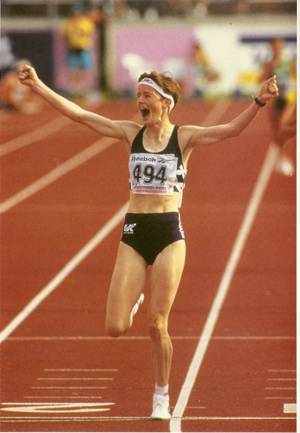
Commonwealth Gold 1994
Tommy, was now managing all of production at the computer plant Livingston. They had been taken over by Packard Bell and moved into producing workstations for the inland revenue and then building desk top computers. The work force was growing, margins were eroding, pressure was increasing. Tommy was working longer hours traveling to Livingston along an ever busier M8. On the athletics front he had fortunately advised Yvonne to move to road which meant she should no longer require all of the intense coaching he had previously provided. This did not sit well with Yvonne, a reaction that would maybe be expected from any athlete, Tommy says “I knew that, however painful, it was the correct thing to do.” He gradually re-aligned to this mode of coaching, until 1998 when Yvonne decided to move on to pastures new: Tommy’s only regret was that, like many sports stars, Yvonne did not appear to be able to move on to the next stage of her life in her mind!! This was indeed the case with very many international sports stars whose whole life has been focused on the sport and Debbie Brill in Canada was one of the pioneers in a movement aimed at re-educating retired or about to retire international athletes. When asked Tommy says, “I had a fantastic experience coaching Yvonne, introducing her to a professional approach to coaching and training, watching her mature into a very successful world class athlete who on her day could compete with the best in the world -which is all any coach can really do!”
Summary of Yvonne’s Achievements
Bronze Medal 1985 European Indoor Championships
Silver Medal 1986 European Indoor Championships
Bronze Medal 1986 Commonwealth Games at Edinburgh
Gold Medal 1987 European Indoor Championships
Bronze Medal 1988 Olympic Games at Seoul
Gold Medal 1989 World Cup at Barcelona
Silver Medal 1990 Commonwealth Games at Auckland
Gold Medal 1990 European Championships at Split
Gold Medal 1993 World Indoor Championships at Toronto
Silver Medal 1994 European Championships at Helsinki
Gold Medal 1994 Commonwealth Games at Victoria
Gold Medal 1994 World Cup at Crystal Palace
– Ranked Number Two in the World in 1994 for the Mile, 2000m and 3000m
– First British Female to win a Gold Medal in the World Indoor Championships
– First British Female to win an individual track Gold Medal in the World Cup
– First British Female athlete in 21 years to win a European Championship Gold Medal in a track event
– The Honour of MBE was bestowed upon Yvonne at Buckingham Palace on 12th March (New Year Honours List 1991)
In an interview with ‘The Scotsman’ what his proudest moments as a coach were, he named four of which “Probably the first one was Yvonne winning a bronze in Seoul (at the 1988 Olympic Games] after only coaching her for a year. That was tremendous.” When we looked at the development of Tom McKean and the initial work done with Yvonne, the evidence of Tommy’s scientific approach was easy to see. What we note from the development of Yvonne – already a very good athlete when she asked him to coach her – is the ‘coaching as an art’ side of things. If you read Yvonne’s own profile you will see some evidence that she learned more about racing tactics with him.
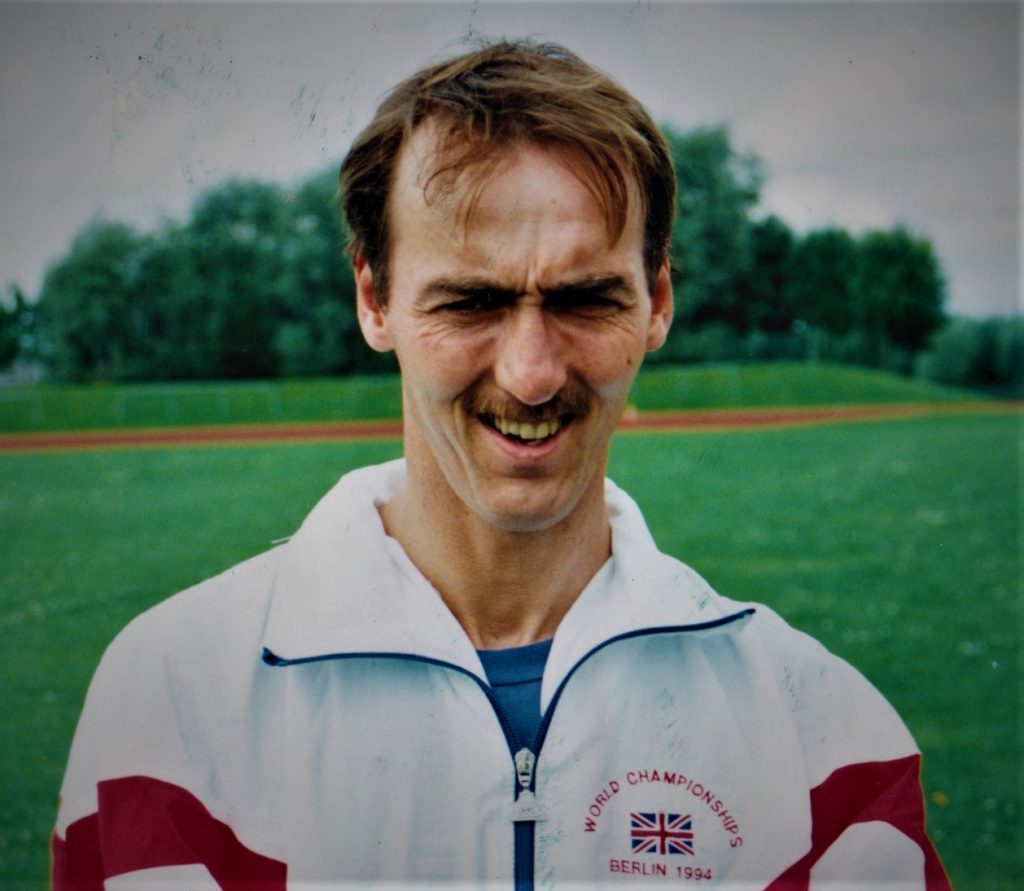
One of Tommy’s lesser known but equally good athletes was Peter Meechan from Newmains, Lanarkshire, who was a Special Olympics athlete who specialised in the pentathlon and the more explosive field events. Over the period between 1982 and 1993 he competed three times for Great Britain and 17 times for Scotland. In the course of that period he won 14 gold medals, 5 silver and 1 bronze, including gold at the Special Olympics. Peter was one of Yvonne Murray’s training partners. He was at times very direct in his comments and at one point said to Tom, “you need to toughen up against the Kenyans“, this was during the time when the team were prepping him with 1000 metre runs for the head to head with Paul Ereng at Crystal Palace (see further up this page) which was one of Tom’s greatest performances.
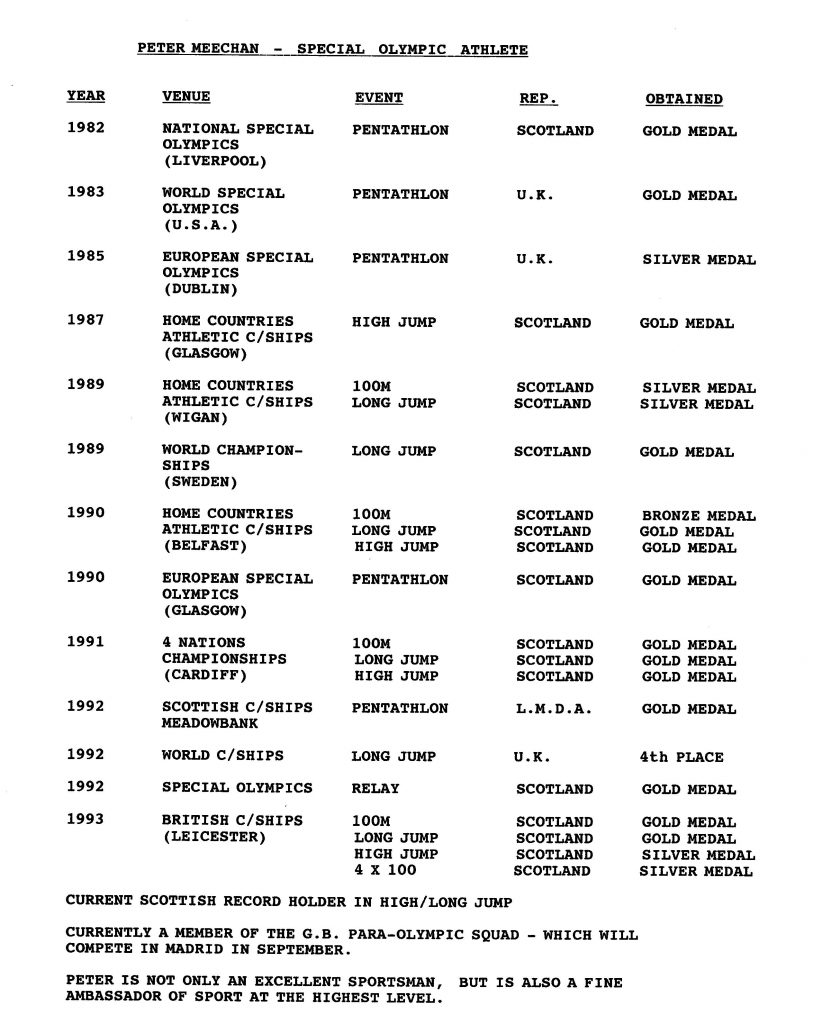
Tommy Boyle was a very busy man now, however, he still had a burning desire to put something back into the local community and especially athletics. Throughout the 90s he continued to support, indeed coach, young athletes and convinced Motherwell District Council to invest in an athletics development project, involving the appointment of an athletics development officer. Tommy was quoted in the local press as saying “we must move into the 21st century. Society cannot expect volunteers to run sport it should be the responsibility of the community to recognise the importance of sport in developing the Health and Wellbeing of all young people”. The package was valued at over £50 k per annum. Always a visionary, Tommy also recognised that if athletics were to survive in tomorrow’s society, it would require to address the issue of inactivity back in the communities rather than just at centralised sports facilities.
Perhaps we get an insight into his thinking in the vision he had about the way society would go in the name of the project he pioneered in an attempt to get political focus on the declining fitness of young people, especially in deprived areas where drugs were becoming an easy alternative to activity. Tommy managed to leverage off the high profile of himself and his athletes and succeeded in securing funding from Team Sport Scotland, Scotland Against Drugs and dozens of local companies to launch COMMUNITY ATHLETICS 2000. This involved establishing satellite athletics clubs in local schools and community centres and training local people to become self sufficient
He says, “I remember we had a big inter club competition in Kelvin Hall, one of the local bus companies provided free transport for all and John Anderson agreed to compere the event. It was awesome; we set up 16 clubs. The concept was miles ahead of its time however politics intervened. The politicians were so busy in-fighting regarding the establishment of North Lanarkshire with all its political factions and the project became a victim. One high profile councillor later commented –“Yes Tommy, way ahead of its time – however we would all give an arm and a leg if we could establish these clubs in to combat the decline in fitness in todays communities and the price we will all have to pay for the NHS”.

Tommy remembers many fine athletes who came through the athletics development project in the 90s, and says: “We had established a great team of coaches supported by many fine PE teachers we paid to run Saturday morning coaching clinics, where typically three hundred young athletes in loads of events would be coached. I was extremely fortunate to help hundreds of young athletes on their journey and has detailed one sample of the class of 1997 medallist in Motherwell Athletics Club
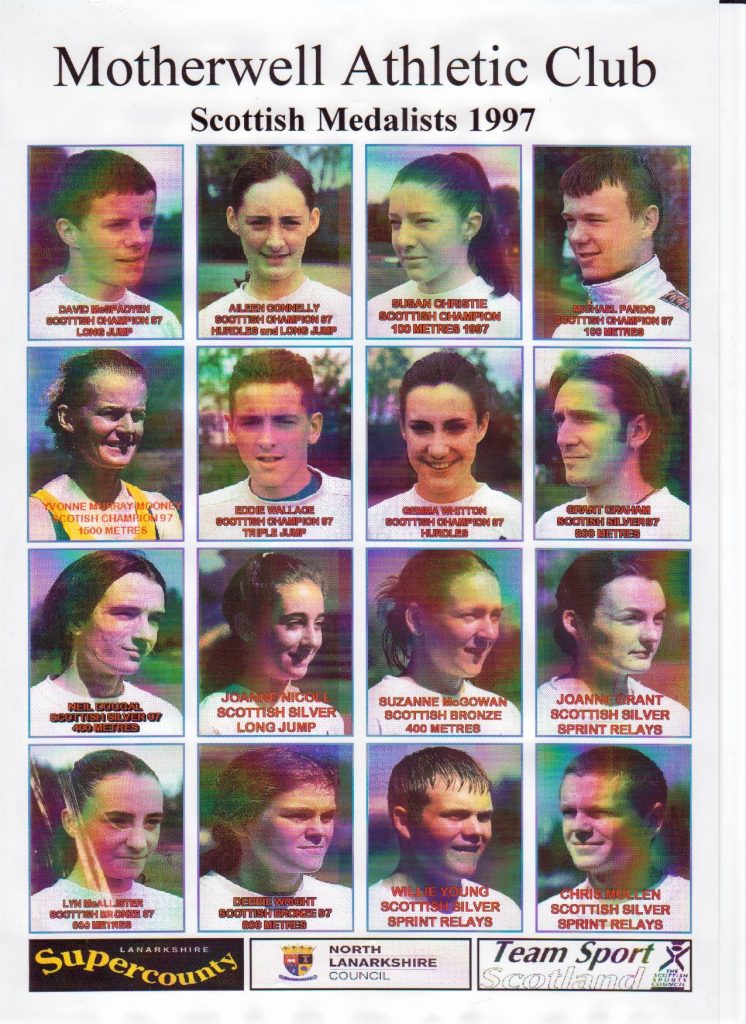
Life was quite hectic for Tommy: he now had a young family, he was traveling to Livingston daily where he had been promoted to Director of Operations in Packard Bell with up to 500 staff which was running 24-7 at peak season. His days became increasingly long, and it was time to pull back from athletics and focus on family and business. This he did, coaching only a few athletes when he had the time and motivation. However his priorities, not to say his passion, was now running a business and raising the family!
Fate intervened once more Tommy was asked to take on a young athlete – Susan Scott. 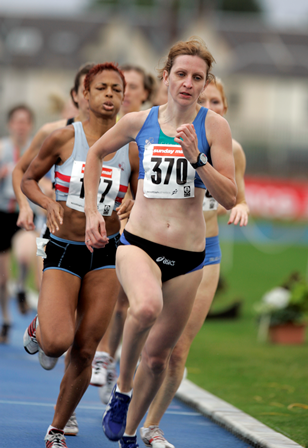
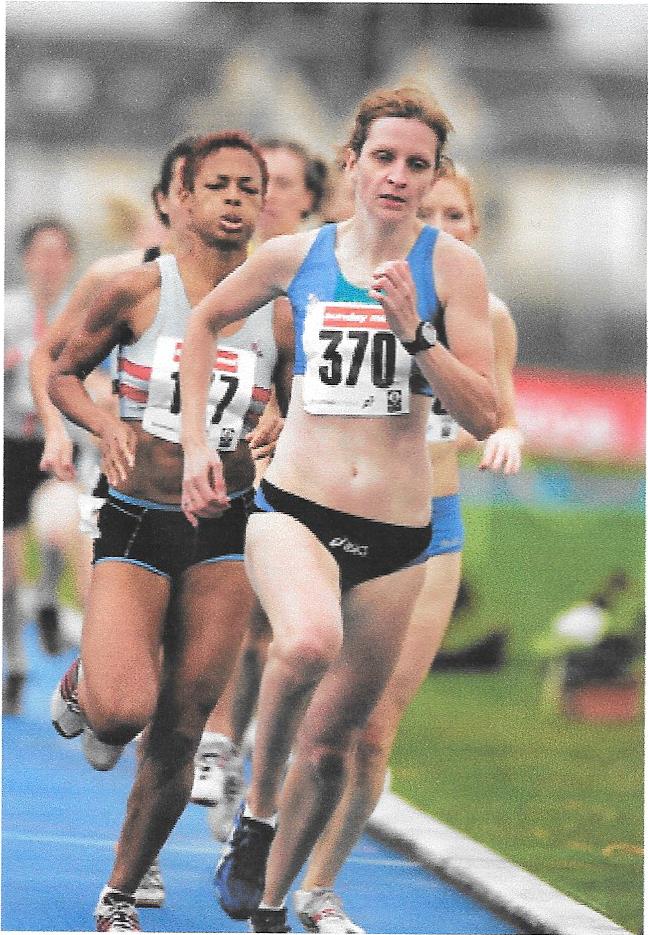
Susan Scott (26th September, 1977) was a considerably good runner who was originally trained by John Montgomery before she came under Tommy’s wing. For the bare facts, her Wikipedia entry reads as follows:
“Susan Scott (born 26 September 1977) is a Scottish track and field athlete who competed for Great Britain at the 2008 Olympic Games in the 1500 metres. She also finished fourth in the 800 metres final at the Commonwealth Games in 2002 and 2006. Scott was born in Irvine, North Ayrshire, Scotland. Representing Scotland, she finished fourth in the 800 metres final at the Commonwealth Games in Manchester 2002, and Melbourne 2006. In both finals, she broke the Scottish record. In running 1:59.30 in the 2002 final, she improved her best by over a second and broke the longest standing Scottish track record to become the first Scots woman to run under two minutes. The previous record of 2:00.15 by Rosemary Stirling, had stood for 30 years. Scott improved on this in the 2006 final with 1:59.02, which stood as the Scottish record until 2014, when Lynsey Sharp ran 1:58.80. As of 2015, Scott ranks 11th on the UK all-time list. Her 1500 metres best of 4:07.00, was set in June 2008. At the 2008 Beijing Olympics, she was eliminated in the heats of the 1500 metres.”
Tommy agreed to coach Susan on the clear understanding that it would be within the constraints of his time. However, Tommy now had perfected a tried and tested methodology Myra agreed to help in her spare time again no stone was left unturned in the pursuit of excellence however by this time we had an institute of sport and that solved a few issues for Tommy. He says perhaps it is best to read the 2005 lecture on Susan but once again proved just how good a coach he was in taking a 2.08 athlete to such heady performances. Tommy added: “I was very fortunate to have the support of my old pal, Frank McMahon, who was Susan’s Minder whilst she did weights in Local Authority Gyms. Frank, pictured below with Susan, called a spade a shovel – just what she needed to bring her out of her very deep shell. Frank was also great support when he came out to Melbourne with us for the Commonwealth Games in 2006.
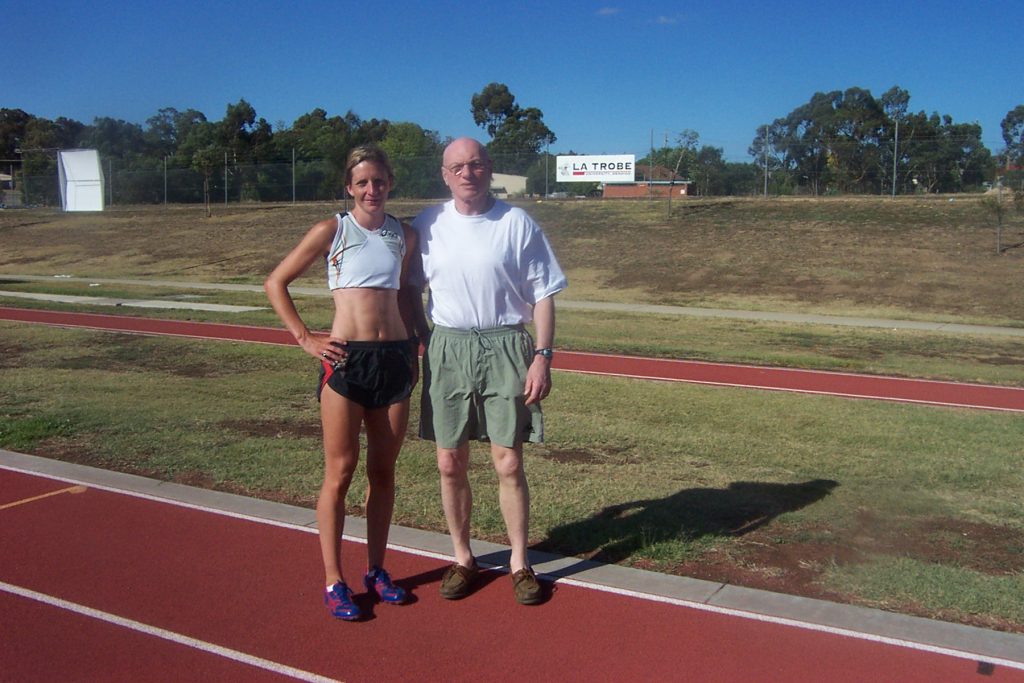
A measure of the preparation Tommy did for Melbourne was contacting the head coach at Bendigo athletics Club, Peter Barratt. He did not believe Tommy would trust him with his top athlete. However he arranged everything for Susan including the critical training partners and supported her in a very successful series of three races which she won before the Games. She is pictured below with the Bendigo training team and some club members .
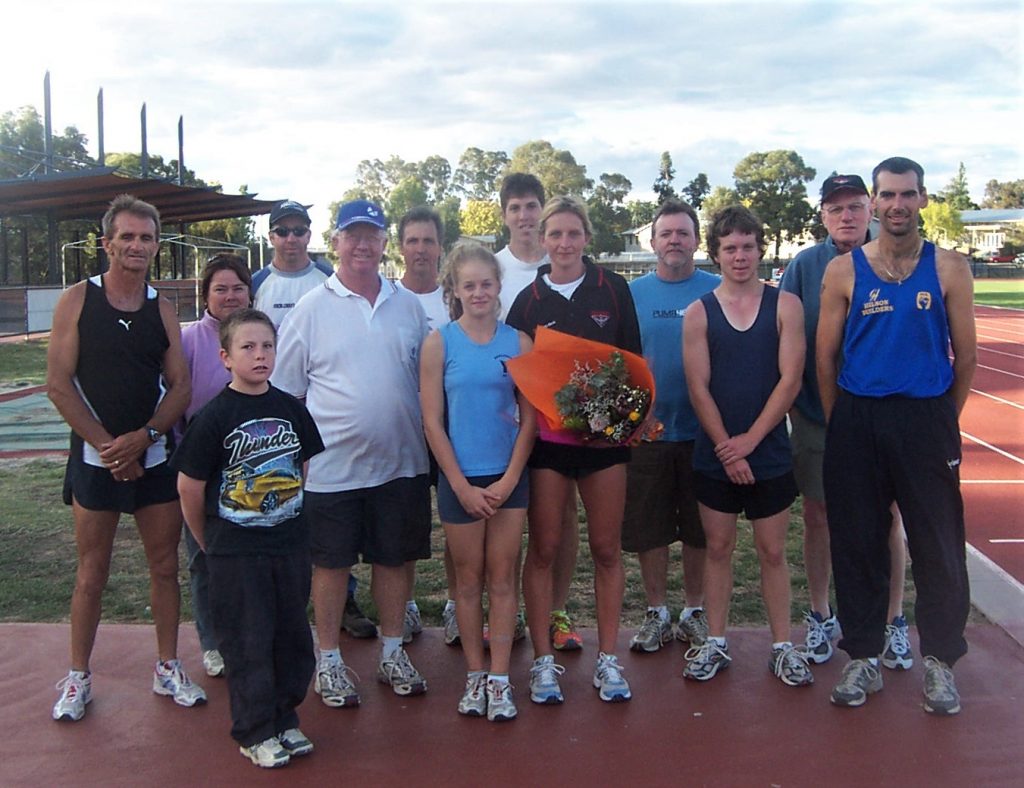
detailed below the key performances of Scott when Tommy coached her.
Age Year / Date PB 800 Major Event Psn Time
Phase IV 32 2010 C Comm. Games/European Champs
31 2009 World Champs
30 2008 Olympic Games
29 2007 World Champs
28 2006 Comm. Games/European Champs
27 2005
Example of a Competition Year 21/8/05 Norwich Union Super GP 2nd 2:03.77
14/8/05 Scottish Champs (Gold) 1st 2:02.85
7/8/05 2:01.17 IAAF World Champs (Season Best) 8th 2:01.17
22/7/05 Norwich Union Super GP 3rd 2:02.06
10/7/05 AAA Champs & Trials (World & Comm)
(Gold) 1st 2:02.97
27/6/05 Josef Odlozil Memorial GPII (1500m) 2nd 4:14.84
12/6/05 Lille GP (1500m) 6th 4:09.10
Phase III 26 2004
Example of a Competition Year 15/8/04 Scottish Champs (Gold) 1st 2:02.85
14/8/04 Scottish Champs (Gold) 1st 4:17.0
30/7/04 2:00.71 Crystal Palace GP 4th 2:00.71
24/7/04 GB Match 6th 2:03.00
17/7/04 BMC 1st 2:01.70
14/7/04 Lahiti Games 1st 2:01.46
11/7/04 AAAs (Bronze) 3rd 2:02.13
27/6/04 Gateshead GP 6th 2:01.40
19/6/04 Euro. Cup (Bronze) 3rd 2:01.35
12/6/04 BMC 1st 2:00.77
2/6/04 Open Graded 2:01.87 mx
22/5/04 BMC 2nd 4:10.56
25 2003
Example of a Competition Year 1/8/03 North Down Games (Silver) 2nd 2:03.9
26/7/03 AAAs (Silver) 2nd 2:04.13
29/6/03 GB v. USA v. Russia 6th 2:03.16
21/6/03 Euro. Cup 6th 2:04.28
12/6/03 Ostrava GP 5th 2:01.85
1/6/03 2:01.08 Hengelo GP 2nd 2:01.08
GB Int. 5th 2:03
Scottish (Gold) 1st 2:02
24 2002 1:59.30 Commonwealth Games Scot. Nat. Record 4th 1:59.30
AAAs (Gold) 1st 2:03.84
23 2001 Scottish (Gold) 1st 2:06
European U23 Champs (1500m) (heat)
Phase II 22 1999 AAAs U23 (1500m) (Gold) 1st
20 1998 Scottish Champs 800m (Gold) 1st
19 1996 Scottish Champs (1500m) 3rd John Montgomery
Scottish Schools CC 2nd
Scottish CC Champs (Gold) 1st
British Schools Indoors (Gold) 1st
Phase I 15 1992 Scottish 800m Champ U15 (Gold) 1st Graham Greenham
14 1991 British Schools CC West District Champ
13 1990 Scottish CC Champ (Gold) 1st Glen Harrow
11 1988 Scottish CC Champ (Gold) 1st
Domestically Susan won the 800m 5 times and the 1500m twice (one indoors) in Scotland, and at GB level she won the 800m twice and the 1500m once (indoors) for eight GB medals in total including one at 3000m. These were between 1998 and 2009.
In the ‘Scotsman’ interview mentioned above, Tommy mentioned as one of his proudest moments “Susan Scott breaking the Scottish record at two successive Commonwealth Games – first in 2002 in Manchester and then in 2006 in Melbourne.” His pride is entirely justified in that the first time she broke the national 800m record, it was one that had been in existence for all of 30 years and had withstood attacks by such big talents as Ann Purvis, Margaret Coomber, Christine and Evelyn McMeekin, Lynne McDougall and others. The fact that she then retained the record until 2014 is another testament to the value of the time.
Word of Tommy’s coaching and the performances turned in by Tom had got around: this fact was highlighted in a story of an incident that took place in Portugal Tom was doing three .x a minute intervals 3-3-3 minutes They noticed a guy watching from the bushes. The guy was Steve Ovett . So they spoke to him and subsequently they had a few long chats. Steve’s perception was that they didn’t do long reps. He was astounded He also loved the set approach. He also said Tom should race more ( a common misconception in Britain at the time) When Tommy asked how many T0m had done last year, he said seven, it was 15 – all world class, televised for sponsorship. Again he is reported to have said, “wow how wrong can you be?” and praised the Scots’ business led approach which allowed us a freedom to do what we wanted not what an agent wanted.
But just as others wanted to pick up information from Tommy, so he was always learning himself. Tommy was a supporter of the British Milers Club and he has this to say of the club:
“In my early coaching days, I was an observer of the BMC strategy being shaped by Frank Horwill and his band of knowledgeable fellow coaches around the country. Over the years as I learned more and observed the massive benefits which it provided to young middle distance athletes and their coaches.
Clearly a model of delivery which was simple slick and effective ,one where athletes were centre of the focus, just get on with providing graded races providing opportunities for all of the athletes to improve on their personal best – exactly what every young person wants from the sport .
I was often asked why we did not use them with Tom, really quite simple he was a fast twitch fibre man and our strategy was to pursue the sprint 400 to 800 route . I remember John Anderson as national coach saying this is the way ahead for clubs and competitions, sprint and hurdle competitions, jumps competitions ,throws competitions and of course multi-event competitions
My belief is that this is even more relevant in today’s world where athletes, officials, volunteers and parents do not want to spend all day at league matches half way across the country . I was privileged to be invited to share my coaching knowledge and experience at BMC events on several occasions, and one night after the formal stuff spent hours in a room with Peter Coe, Wilf Paish, Norman Pool, Gordon Surtees and a few other legends of coaching it was amazing .
Finally a measure of how much I admire the BMC Competition structure is that this year 2018, my son Christopher returning to competition after two years out through injury had a competition programme which consisted of six BMC competitions where he gained massive experience racing at his own level and from May to August gradually improving his PBs , winning one race – with resultant massive confidence boost: is that not what coaching is all about providing the opportunity for young people to become the very best they can be?
I will never cease to be amazed about how BMC just make it work !”
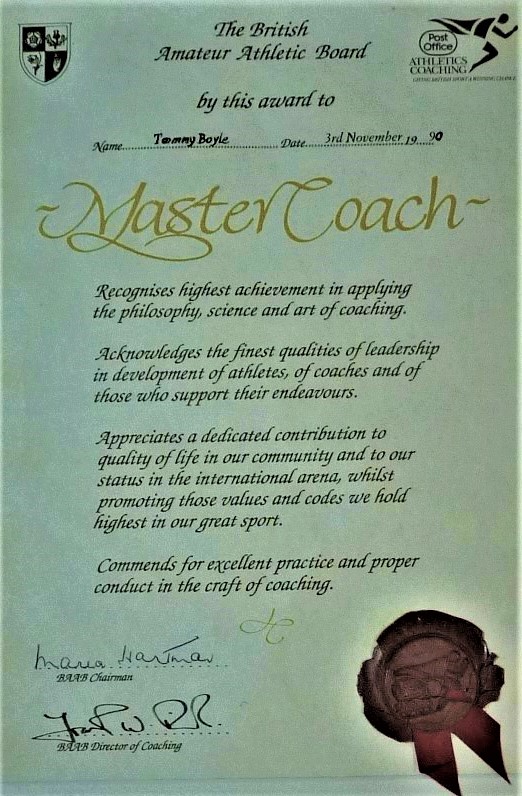
This profile has not been about Tom McKean, Yvonne Murray, Susan Scott or any other athletes. It has been about Tommy Boyle, whose Mastercoach certificate is above, his methods and his progress on the world stage. What have we found out?
- First that he is prepared to work long and hard away from the training venues to evaluate and calculate.
- Second, he pays great attention to detail.
- Third we have found out that he is very honest with the athletes and, more important, with himself.
- Fourth, he is prepared at all times to learn what he can to increase his own knowledge and to develop his athletes’ competitive advantage.
These are not qualities unique to Tommy but where were these qualities to take him next?

Tommy, the family man (but who’s looking over his shoulder?
“Retirement is fantastic”, says Tommy, “loving the time to spend with my ever-supporting wife Julie who has supported me on every stage of my coaching and business life and without whom I could never have done a fraction of the things I have achieved in sport and in my life.
I now have the time to learn more about my other passion, gardening indeed an old gardener from a local village is teaching me how to grow begonias, maybe even competition ones!
However both of my two sons are now doing athletics: Christopher competes for Victoria Park in 800m and Adam is no 1 in Scotland for Javelin at his age group . His coach is Karen Costello and they are mentored by Mike McNeil, who coached Goldie Sayers to the Olympics; Chris has a training partner called Steven Bryce – a young para athlete, who is coached by his dad, Allan, and I. He did very well in the recent LA Special Olympics ,winning a gold silver and bronze “
We started the page with a picture of Tommy with a quite prestigious award and we can finish with another. Note this communication from June 2010:
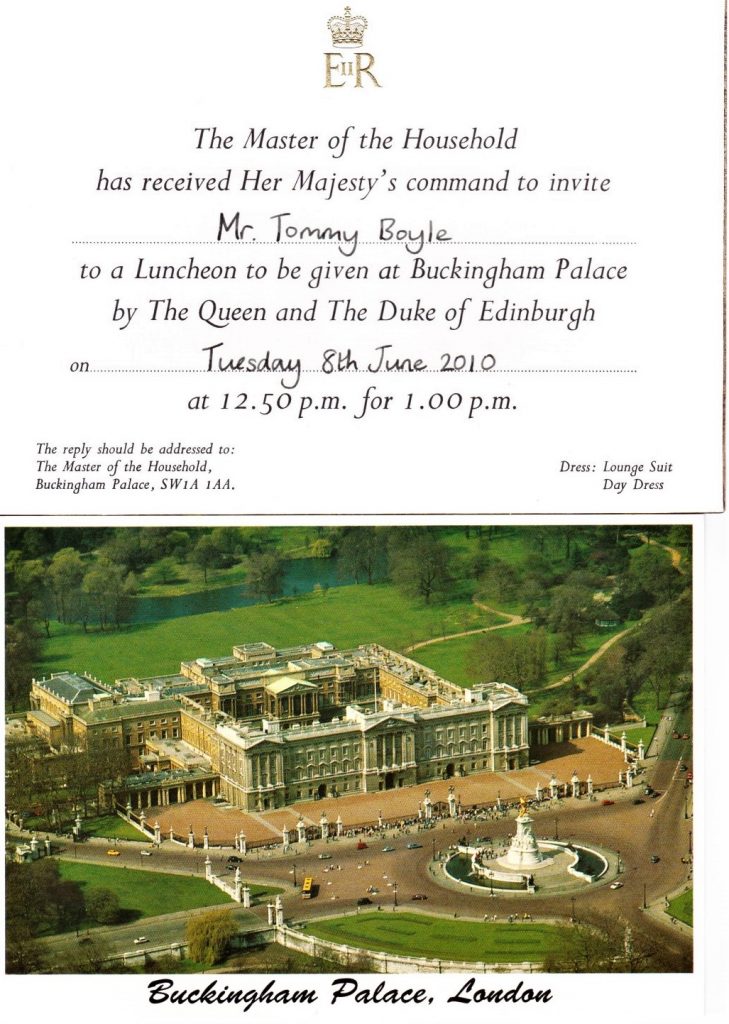
Tommy was invited to lunch with the Queen and Prince Philip in Buckingham Palace in recognition of his service to sport and youth. He says of this that he has received many an award throughout his career but this is one of the two that mean most to him. The UK coach of the year and “this invitation and discussion with HRH the Queen. It was an awesome day.”
But let’s not forget that Tommy Boyle is a coach and a family man – the photographs below show both sides.

Steven Bryce
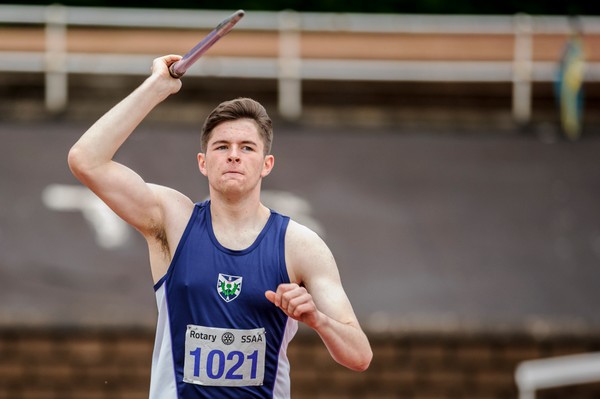
Adam Boyle, Scottish Schools Athletics – Nat Champs 2017 (C)Bobby Gavin
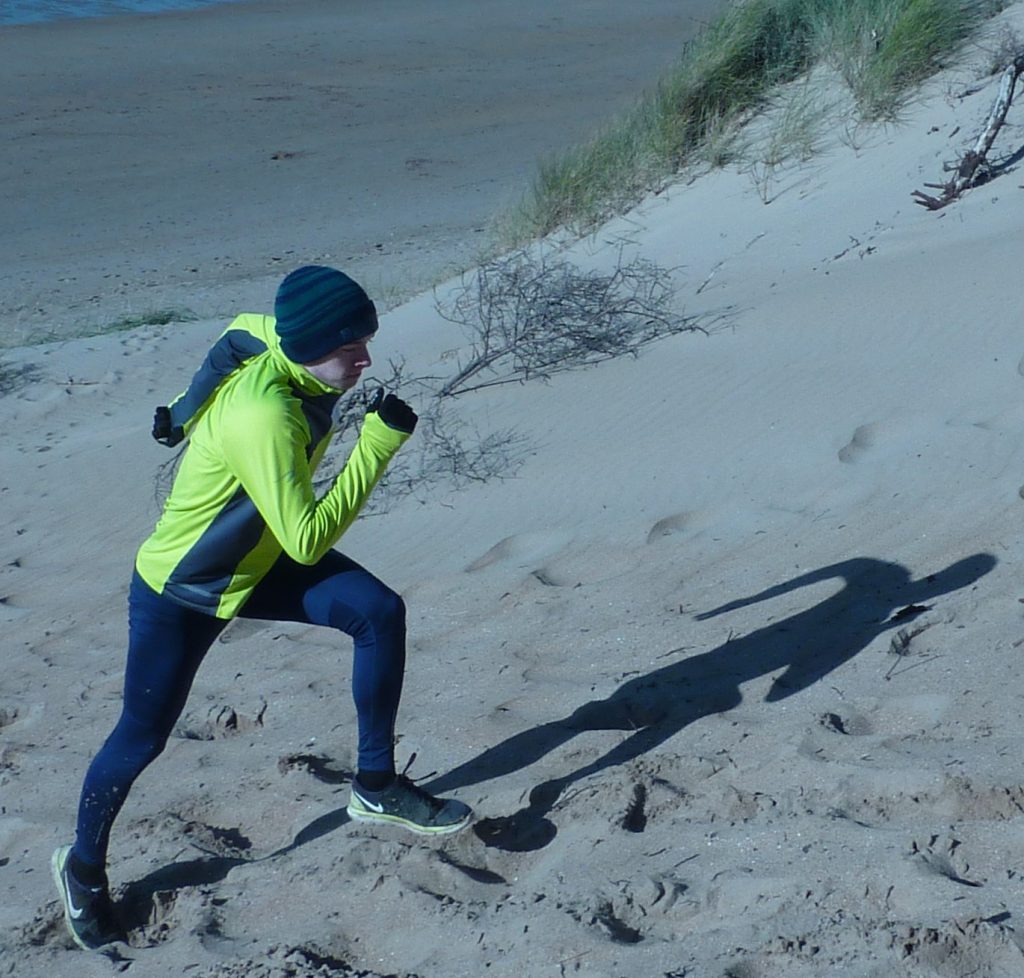 Christopher training at Gullane
Christopher training at Gullane
